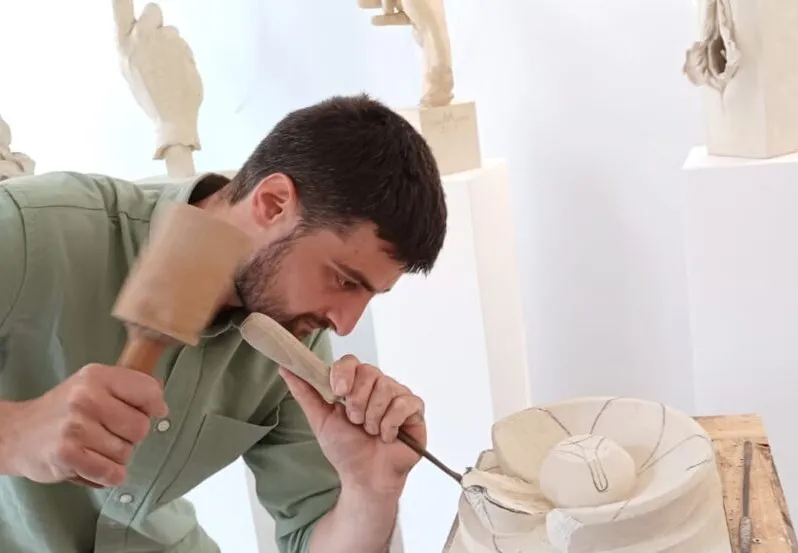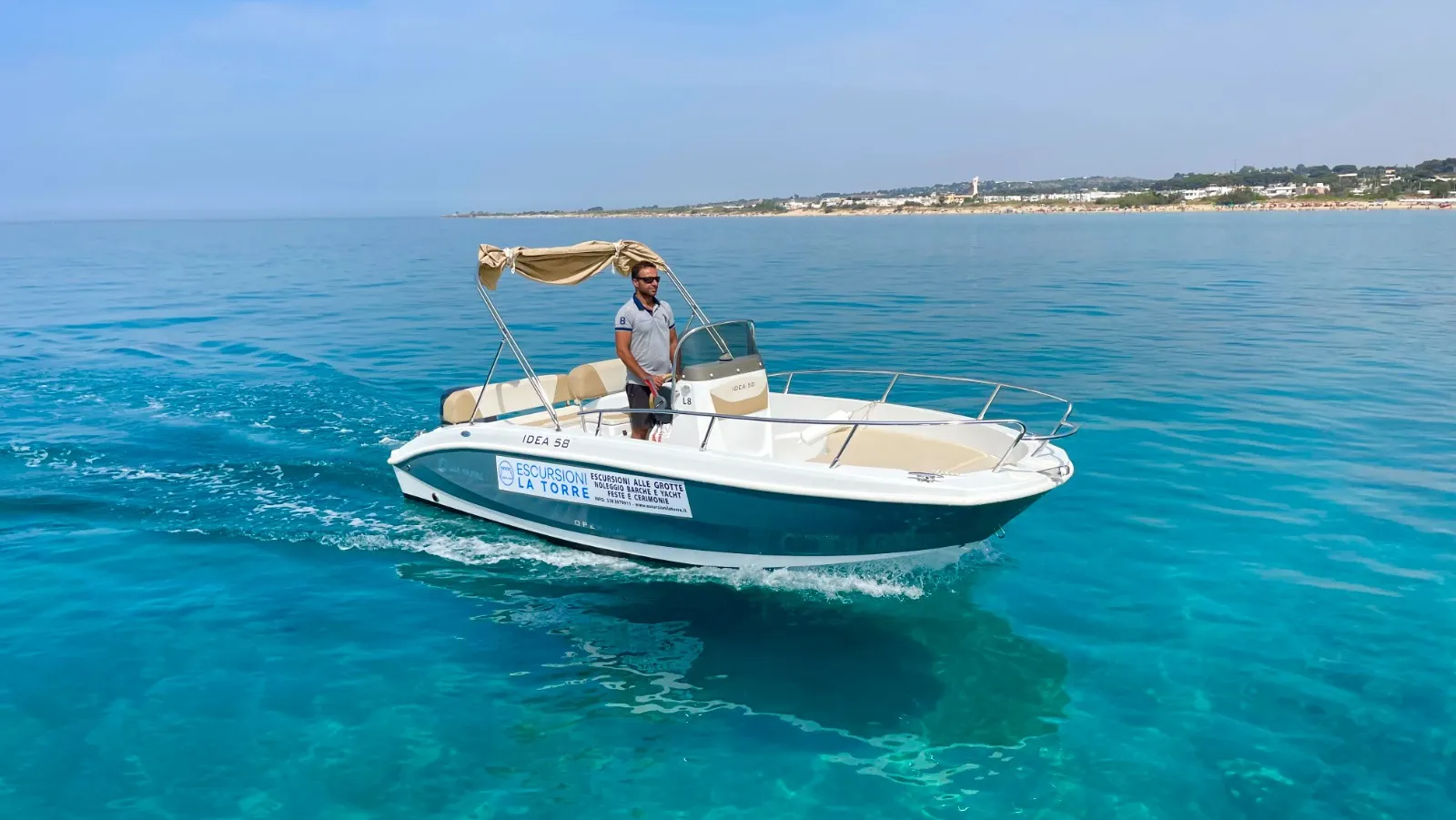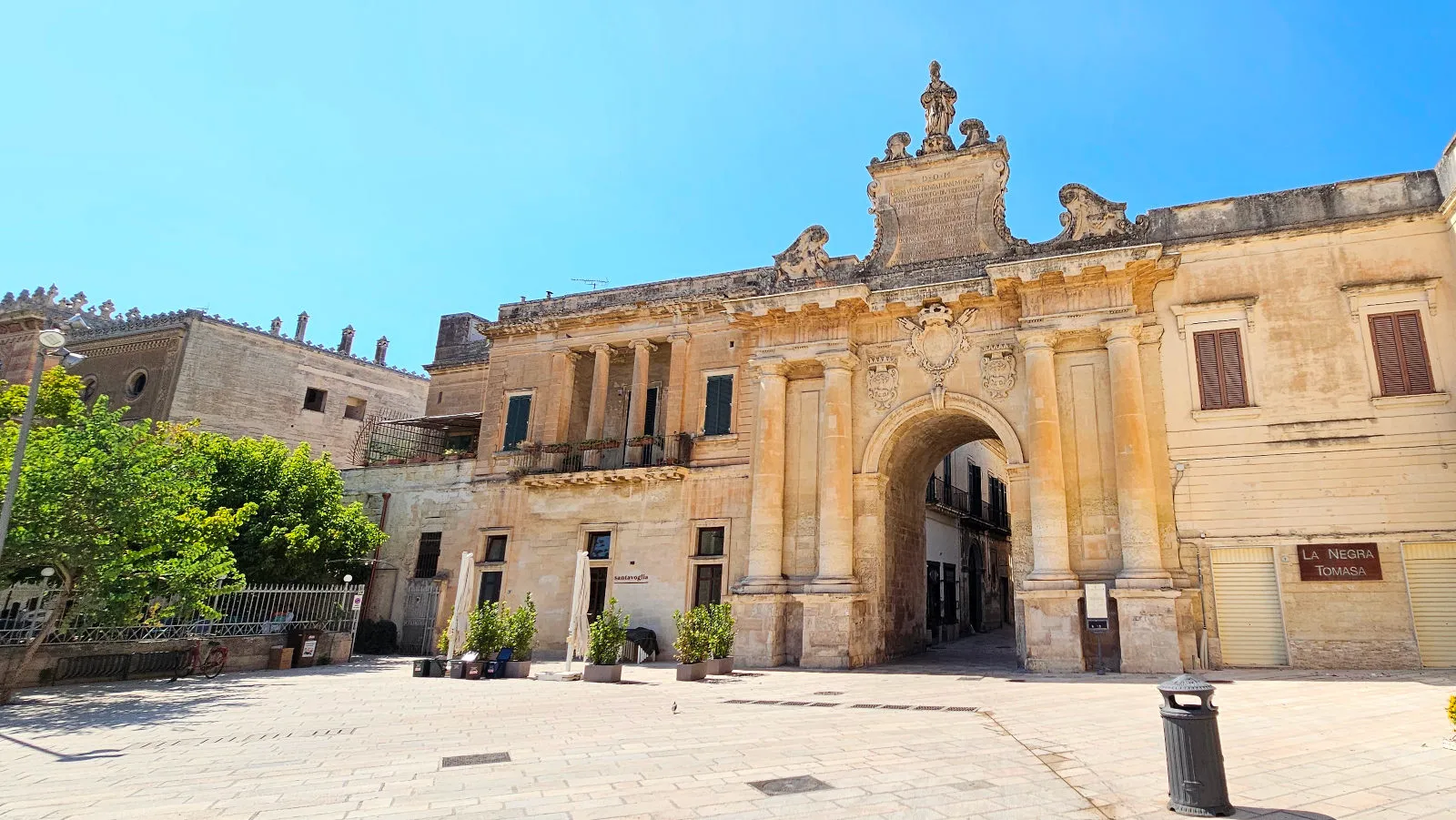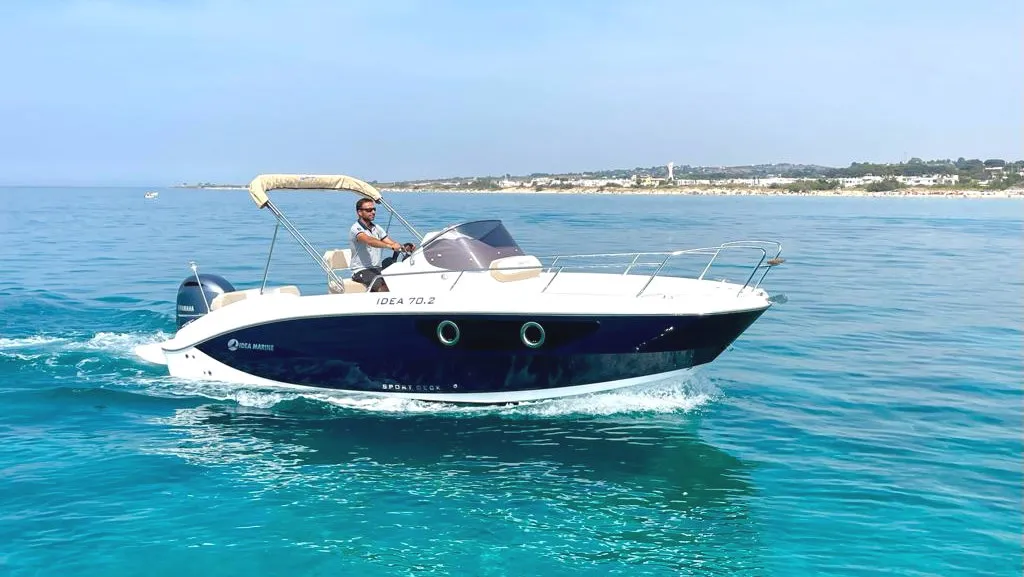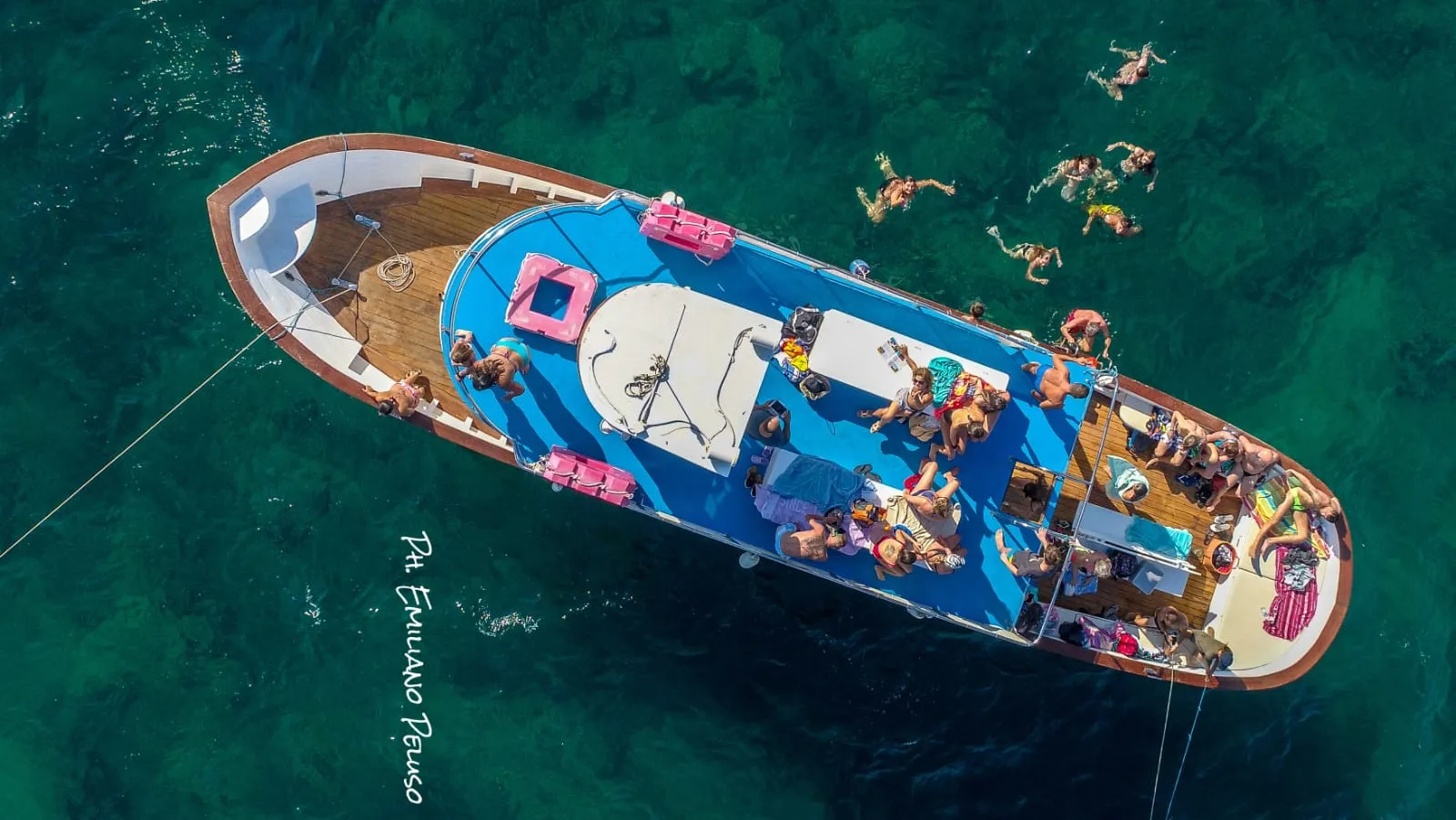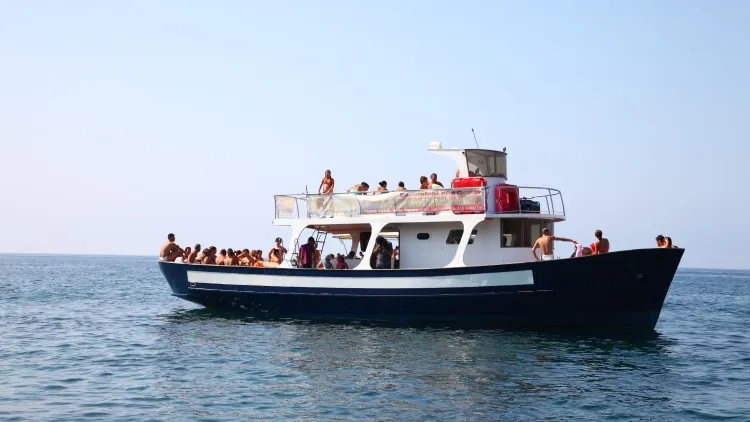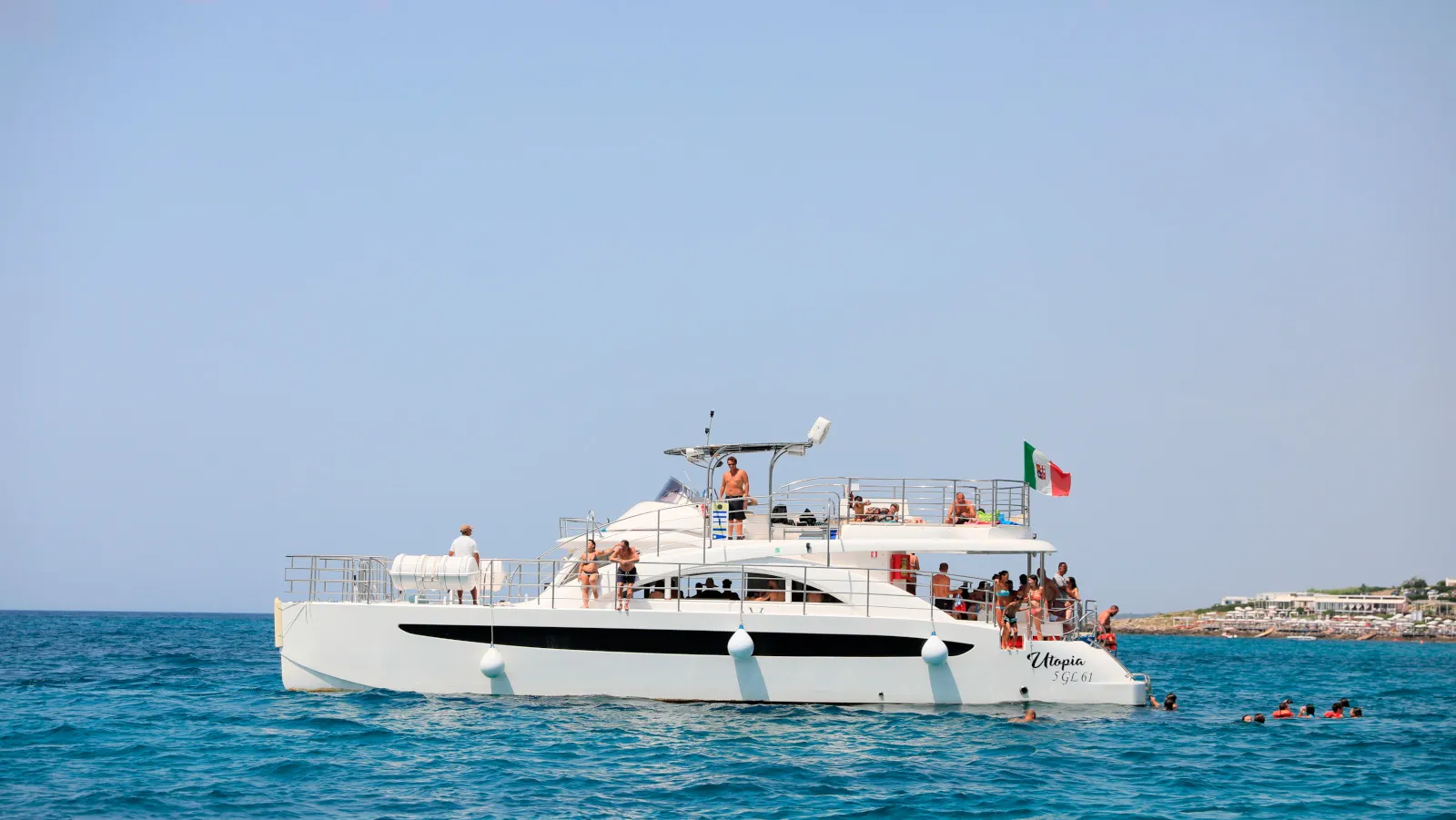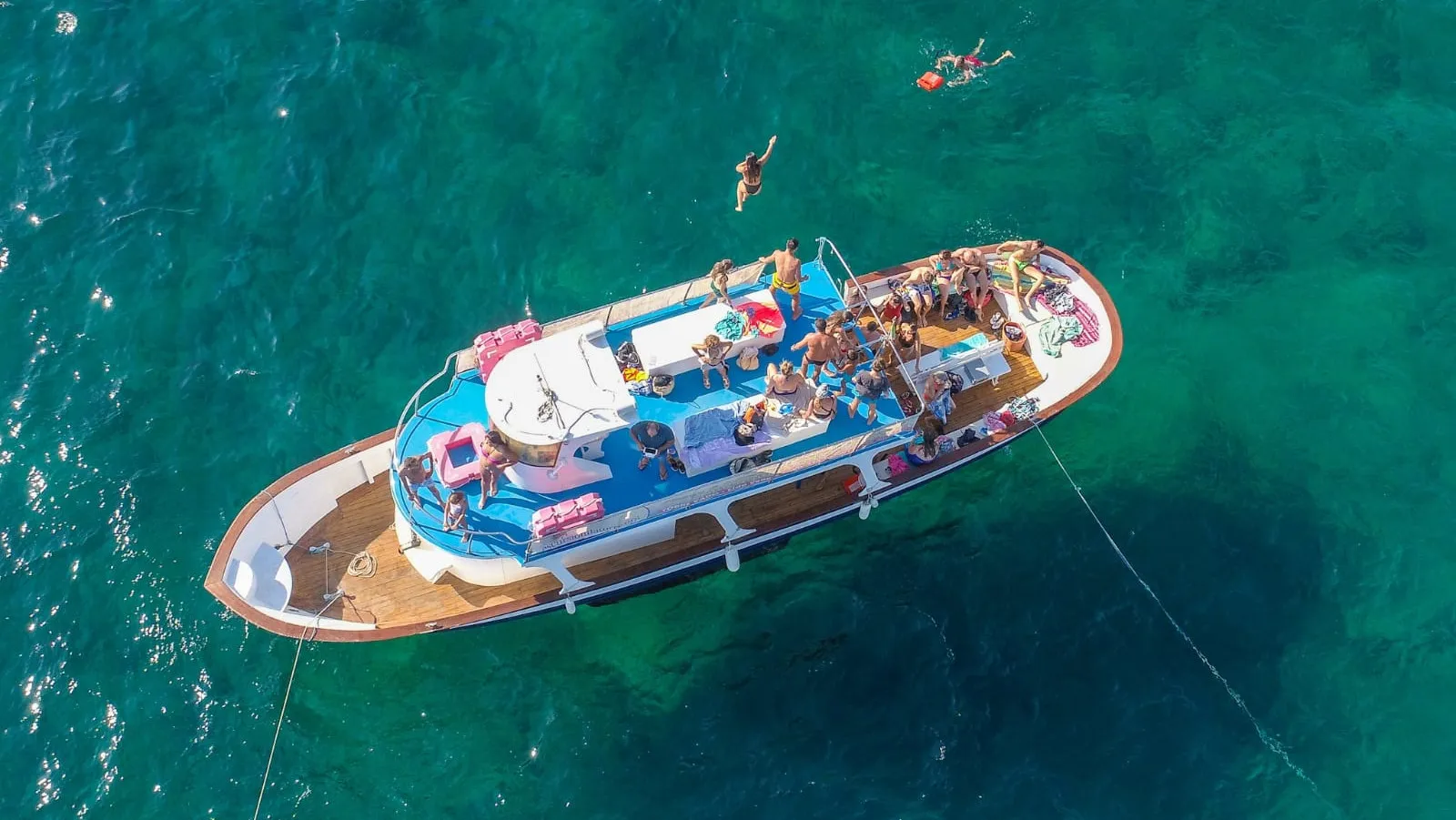Santa Maria di Leuca: what to see and do [Guide]
Updated at: 20-09-2024
How this content can help you:
Sure! Here's the translation in English:- You will discover the history and culture of Leuca: archaeological sites, churches, castles, and palaces.
- You will visit the Sanctuary of Santa Maria de Finibus Terrae, the "Gateway to Paradise."
- You will get to know outdoor activities: snorkeling, diving, biking, and horseback riding.
- You will discover the most beautiful beaches to visit.
- You will explore the coastal caves by boat.
- You will participate in local events and festivals.
- You will take scenic tours and visit 19th-century towns.
- You will taste local wines and typical dishes.
![Santa Maria di Leuca: what to see and do [Guide]](https://bip-static.fra1.cdn.digitaloceanspaces.com/bestinpuglia-production/b8d5e1cc474f98c223aadc0e48b9ba88/santa-maria-di-leuca.webp)
Santa Maria di Leuca is a splendid seaside resort located in the heart of the Salento region, in the province of Lecce, and is part of the municipality of Castrignano del Capo.
This enchanting destination is famous worldwide for being the southernmost point of Puglia, where the Adriatic Sea meets the Ionian Sea. Leuca is a place of extraordinary beauty, nestled between the blue sea and the green Mediterranean scrub, making it one of the most sought-after tourist destinations in the region.
The territory of Santa Maria di Leuca is so vast and rich in surrounding hamlets and localities that it almost feels like an autonomous province.
This ancient seaside village stands out for its millennia-old history and its unique landscape, which is divided into two main parts: the area of Santa Maria di Leuca, located above the promontory, and the part known as Marina di Leuca, which stretches along the coast between Punta Meliso and Punta Ristola.
The latter is known as the southernmost point of Salento, where land and sea merge into a breathtaking natural spectacle.
The seaside village of Santa Maria di Leuca, also known as Marina di Leuca, boasts a historic center rich in historical and cultural value.
The charm of this village is reflected in its ancient churches, millennial monuments, and historical sites that tell the stories of a community that has lived through centuries of events and transformations. The coastal landscape framing these beauties is unique in the world, offering unforgettable panoramic views.
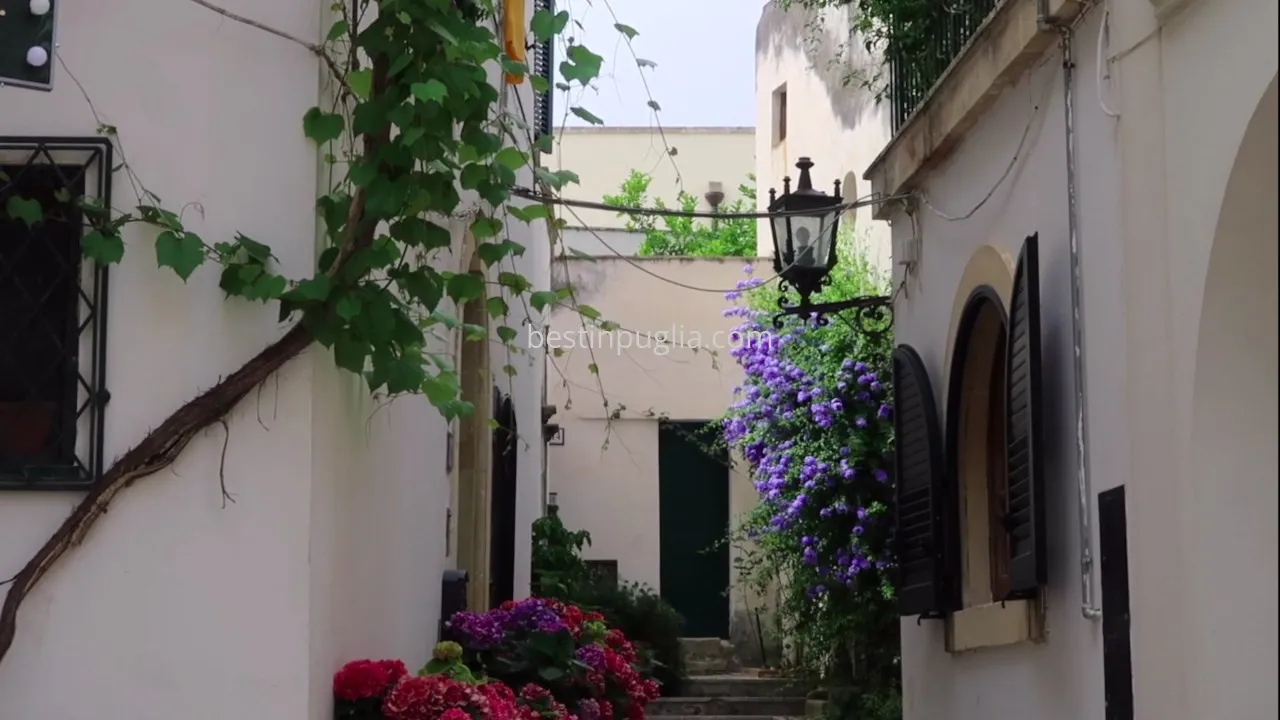
Leuca, Santa Maria di Leuca or Marina di Leuca? What is it really called?
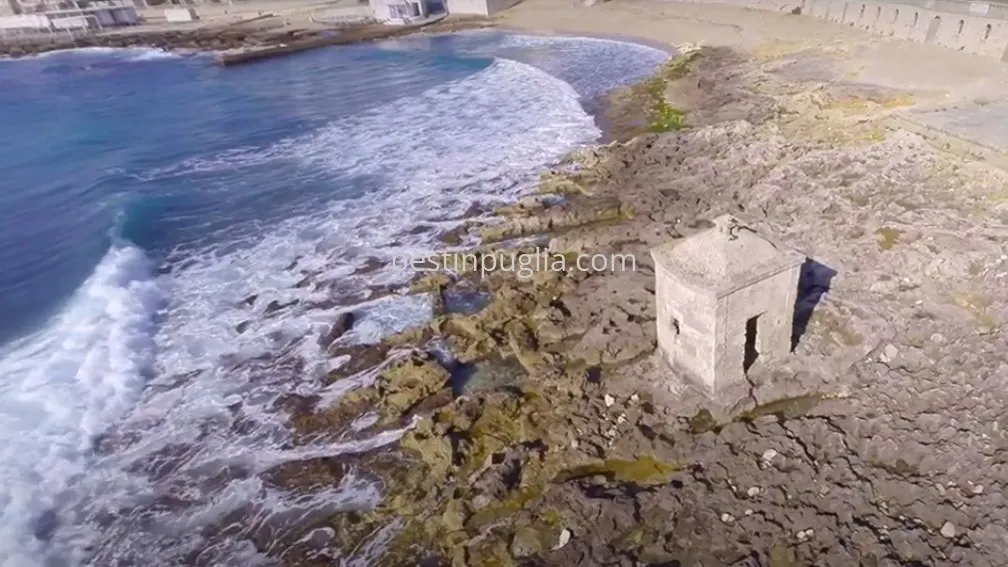
The three names of the region are assigned over the past centuries by the various populations that have crossed and dominated the Salento territories, considered the end of the territories extended towards the east.
All three names are still recognized today to identify the promontory, or part of it.
Leuca
The name Leuca, derives from the Greek "Leukòs", which means white, and was used by ancient navigators in transit to and from ancient Greece to indicate this location between the cliffs. The name probably owes its origin to the shiny rocks overlooking the sea in the area.
Still today, the sensation of space and light, dominated by the white of the houses and stones, strikes the attention of those arriving in Leuca.
Santa Maria di Leuca
For the Romans, the Japigio promontory represented De Finibus Terrae (the end of the lands), or rather the boundaries of the Roman lands beyond which the sea and the provinces were located. With the arrival of the first Christians, the locality became Santa Maria di Leuca, as the Basilica of Santa Maria de Finibus Terrae was built on the site where the first Christian church in the West was to be erected.
Santa Maria di Leuca, therefore, includes the upper part of Leuca with the Basilica and the Lighthouse.
Marina di Leuca
Marina di Leuca is the most recent toponym and appears only in the official deeds following the establishment of Leuca as a fraction of the municipality of Castrignano del Capo. The term Marina di Leuca refers to the lower part of the town, which includes the port and the promenade.
Why visit Santa Maria di Leuca?
Visiting Santa Maria di Leuca means immersing yourself in a unique experience, made up of sea, culture, history and gastronomy, which we strongly recommend to discover.
Here are at least 12 good reasons to visit Santa Maria di Leuca:
- The two seas and the wonderful beaches
- Green holidays among natural beauties
- Mediterranean climate of Salento
- Delicious cuisine
- Parties, Festivals and Festivals
- History and Culture
- Santa Maria di Leuca and the Gate of Paradise
- Outdoor activity
- Relaxing atmosphere
- Attractions close to Leuca in Salento
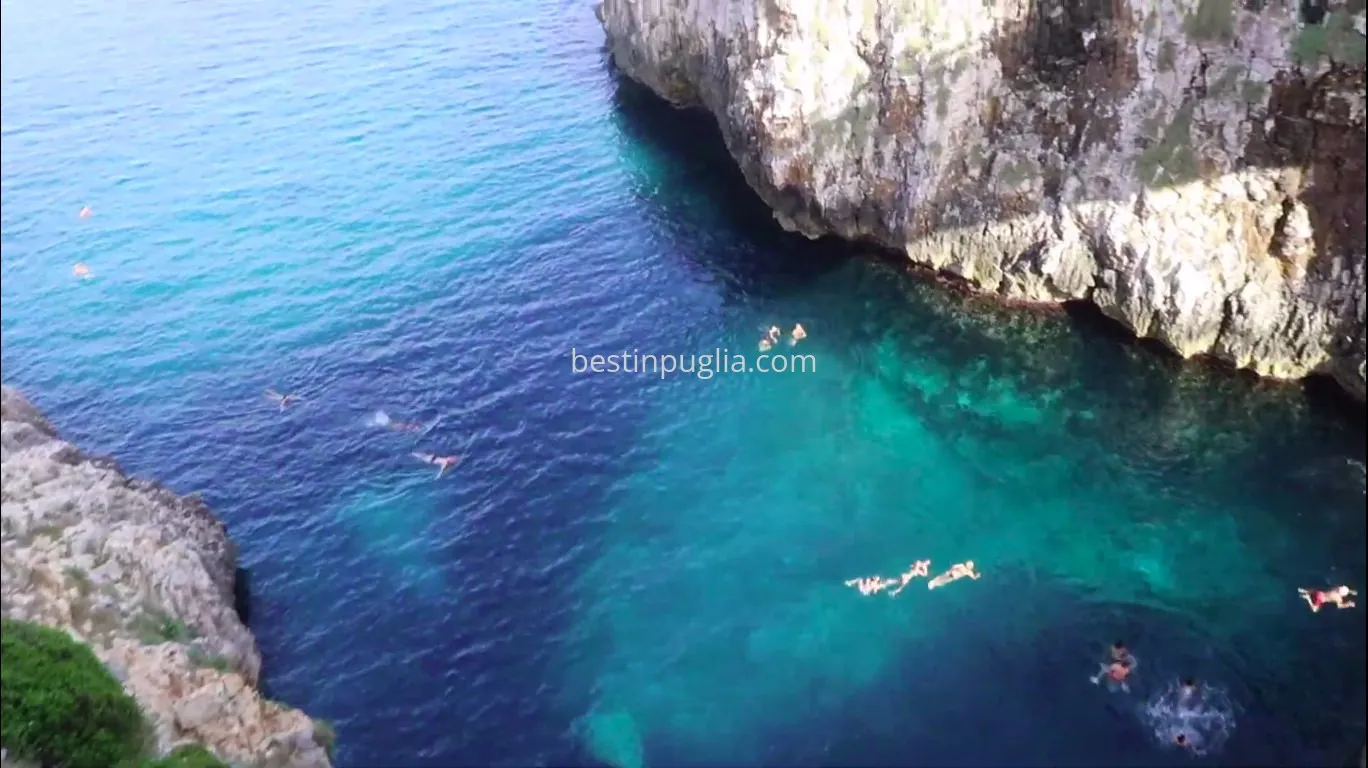
The two seas and the wonderful beaches of Leuca
Leuca is an enchanting place where every day you can choose whether to immerse yourself in the waters of the Ionian or the Adriatic. In fact, from here, in a few minutes you can reach the suggestive Adriatic cliffs or the marvelous tropical beaches of Salento that overlook the Ionian sea.
These two seas are characterized by their crystal clear and clean waters, which invite you to dive in and explore the underwater world.
Among the main attractions of the area, there are the splendid white sandy beaches, such as the famous Pescoluse beach, nicknamed "the Maldives of Salento", where you can enjoy a breathtaking view and a crystalline sea that will leave you breathless .
Green holidays among the natural beauties of Leuca
Salento is famous for the pristine beauty of its nature, which makes it an ideal destination for green holidays and for lovers of natural environments. Visitors will be able to fully immerse themselves in nature, with beautiful coastal landscapes, olive groves, vineyards and wheat fields stretching as far as the eye can see.
Santa Maria di Leuca is the perfect place to spend a holiday in contact with nature, thanks to the wonderful landscape and climate. The warm and comfortable sun of the days perfectly matches the colors of the Mediterranean maquis, which will offer you a breathtaking show.
Walking while on holiday is a regenerating experience for mind and body, and will give you the energy you need, in every season of the year.
In Santa Maria di Leuca you can truly enjoy the beauty of unspoiled nature and spend an ecological holiday of relaxation and well-being.
Mediterranean climate of Salento
By visiting Leuca you will be able to enjoy a Mediterranean climate, characterized by hot and sunny summers, with temperatures that remain pleasant even at night.
This means you can plan your days outdoors without having to worry about bad weather, enjoying every moment of your holiday. You can spend your days at the beach, explore the surroundings on foot or by bicycle, or simply relax in the shade of a tree or on a panoramic terrace.
Furthermore, the Mediterranean climate favors the presence of a luxuriant and colorful flora and a varied fauna, which will offer you an unforgettable experience. If you are looking for a place to enjoy the summer heat and natural beauty, Santa Maria di Leuca is the ideal destination for you.
Delicious cuisine
Salento cuisine is a real treat for the palate, with delicious dishes based on fresh fish, homemade pasta and fresh local ingredients such as vegetables, cheeses and olive oil.
Here, the cuisine is genuine and tasty, a real riot of flavors and aromas that will leave your palate enraptured.
Furthermore, the value for money is excellent, so you can enjoy the most delicious dishes without breaking the bank.
Don't miss the opportunity to taste the typical dishes of Salento and let yourself be conquered by the unique hospitality of its inhabitants.
Festivals and Feasts
Leuca and Salento are famous for their traditional fiestas and festivals during the summer, offering a variety of activities for all tastes. Live music, traditional food, dancing and fireworks displays are just some of the experiences you can enjoy here.
In Leuca, the party never ends: between events, festivals and patronal feasts, there will always be something fun to do.
The most important events in the city take place on Leuca's seafront, making it the hub of the local nightlife.
History and Culture in Leuca
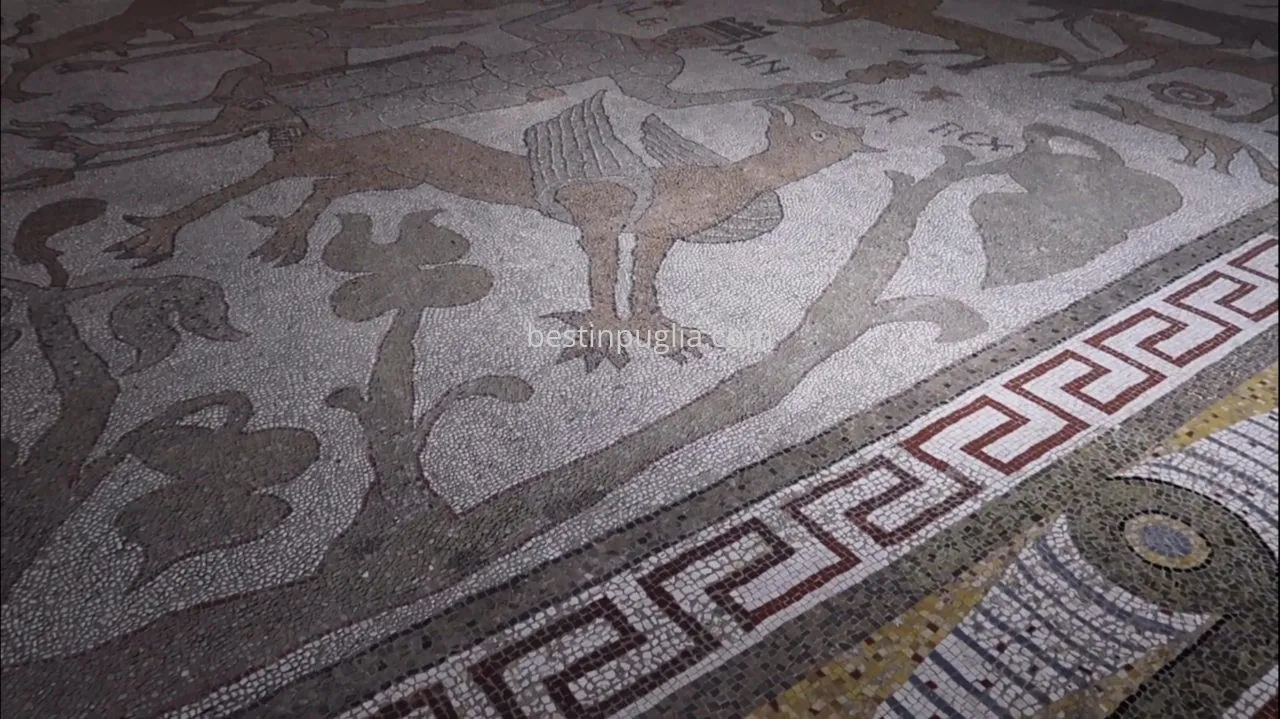
Capo di Leuca, with its ancient history and culture, offers many opportunities for discovery and visits. You will be able to admire many archaeological sites, churches, castles and palaces, which tell the rich history of the area. Furthermore, Leuca was for many centuries an important center of cultural exchange between Italy and the eastern Mediterranean.
Visiting the historical and cultural heritage of Capo di Leuca is a unique experience, which allows you to immerse yourself in the history of the region and to discover the local traditions and culture.
Following the cultural tourist itineraries between the villages and historic centers is a way to discover the wonders that this land has to offer.
Santa Maria di Leuca and the Gate of Paradise
Santa Maria di Leuca is known as the "Gate of Paradise" thanks to its beautiful Marian sanctuary.
This sanctuary represents the last stage of the Via Leucadense, a pilgrimage which, as the ancient pilgrims did, should be accomplished at least once in a lifetime.
Through the path of the Via Leucadense, pilgrims can discover the beauty of the nature and spirituality of Salento.
Outdoor activity
Santa Maria di Leuca offers numerous outdoor activities for all tastes and ages.
The spectacular sea offers several places to snorkel or scuba dive to discover the wonderful marine world.
If you prefer the mainland, in addition to regenerating walks in the spectacular natural landscape, there are also bicycle excursions and horseback riding, which will lead you to discover the natural beauties of the area. Let yourself be conquered by the beauty of Leuca and enjoy the outdoors!
Relaxing atmosphere
Leuca is a seaside destination that stands out for its relaxing and peaceful atmosphere, perfect for those who want a regenerating break away from the chaos and stress of everyday life.
Here you can enjoy a holiday in absolute serenity, surrounded by the beauty of nature and pampered by the hospitality of the locals. Let yourself be conquered by the quiet of Leuca and treat yourself to moments of pure relaxation.
Attractions close to Leuca in Salento
Leuca is an ideal location for exploring the beauty of Salento, as it is within easy reach of some of the region's most famous towns and attractions.
Gallipoli, Lecce and Otranto are easily reached by car or train, making Leuca a perfect base for a tour of the region.
You will be able to discover the historical, cultural and natural treasures of Salento, such as the white sandy beaches, the ancient cities and the enchanting countryside, all a short distance from Santa Maria di Leuca.
What is Santa Maria di Leuca like?
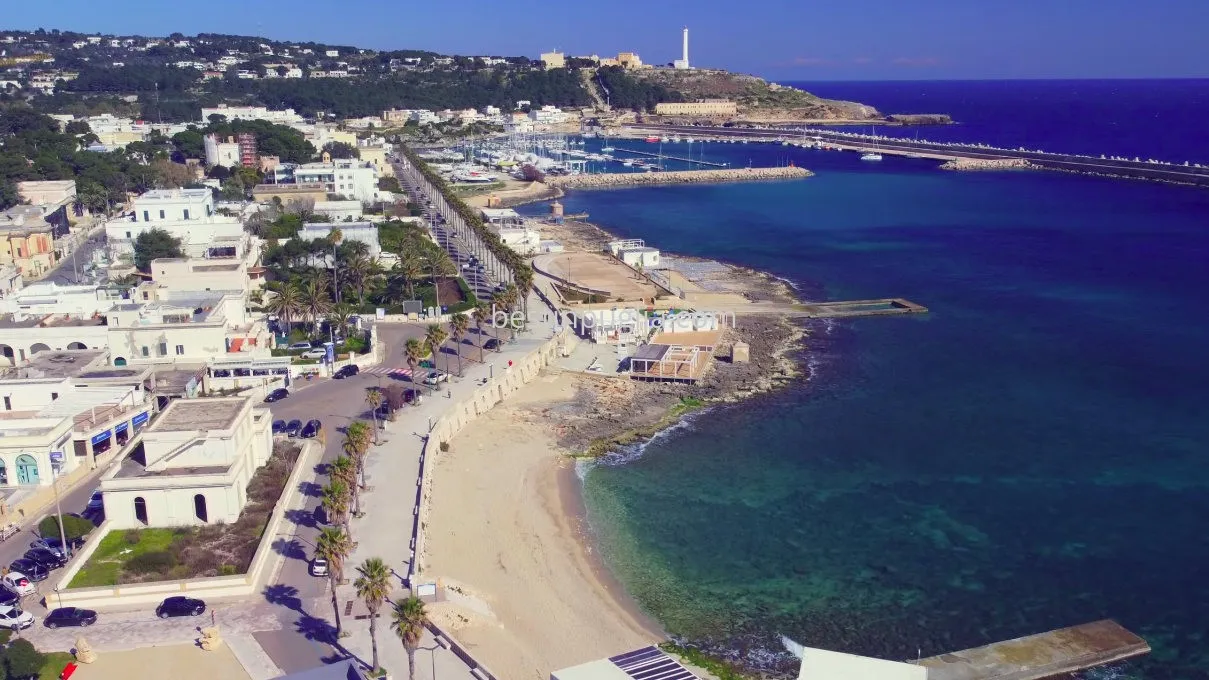
Santa Maria di Leuca in Puglia is a beautiful seaside resort located in the extreme part of the heel of Italy, in the southernmost point of Puglia.
You will find a wild landscape characterized by a jagged and high coast, with an alternation of sandy beaches and coves where you can relax in the sun.
Beyond the various points of interest around the Basilica, the Lighthouse and the historic center of the town, Santa Maria di Leuca is a place famous for its mild climate and low rainfall all year round.
Thanks to the favorable climate, Santa Maria di Leuca has been a renowned destination for travelers from all over the world since the 1800s, who built their summer residence there.
Today in Leuca there are about 50 villas dating back to the 19th century, many of which have lost some of their original features due to the vicissitudes of war and history in general.
Being the southernmost point of the heel of Italy, in certain climatic conditions you can see the meeting between the waters of the Adriatic and Ionian seas, managing to see with the naked eye the dividing line of the two currents and the blue tone slightly different than the backdrops.
The monuments and ancient structures built in the area have very ancient origins, which are lost back in time until they become legendary. The legend concerning Santa Maria di Leuca narrates that in ancient times Aeneas first landed on its coasts. Centuries after Aeneas, it was also the landing place of San Pietro coming from Palestine with destination Rome. In honor of St. Peter, the local population erected a Corinthian column right in the square in front of the Basilica.
Santa Maria di Leuca what to see
The promontory of Leuca, with its wild territory and its millenary history, offers visitors numerous attractions, types of activities to do and things to see. Among the things to see are the classic places of local culture, the ancient villages and the natural wonders offered by the area and a wonderful sea.
The things to see in Santa Maria di Leuca are:
- Historic villas in Santa Maria di Leuca
- Sanctuary of Santa Maria de Finibus terrae
- Church of Christ the King
- Vito Mele Museum
- Omomorto Tower
- Capo Santa Maria di Leuca Lighthouse
- Punta Ristola Leuca
- Punta Meliso
- Monumental waterfall
- Cave of the Three Doors
€ 160
€ 500
Historic villas in Santa Maria di Leuca
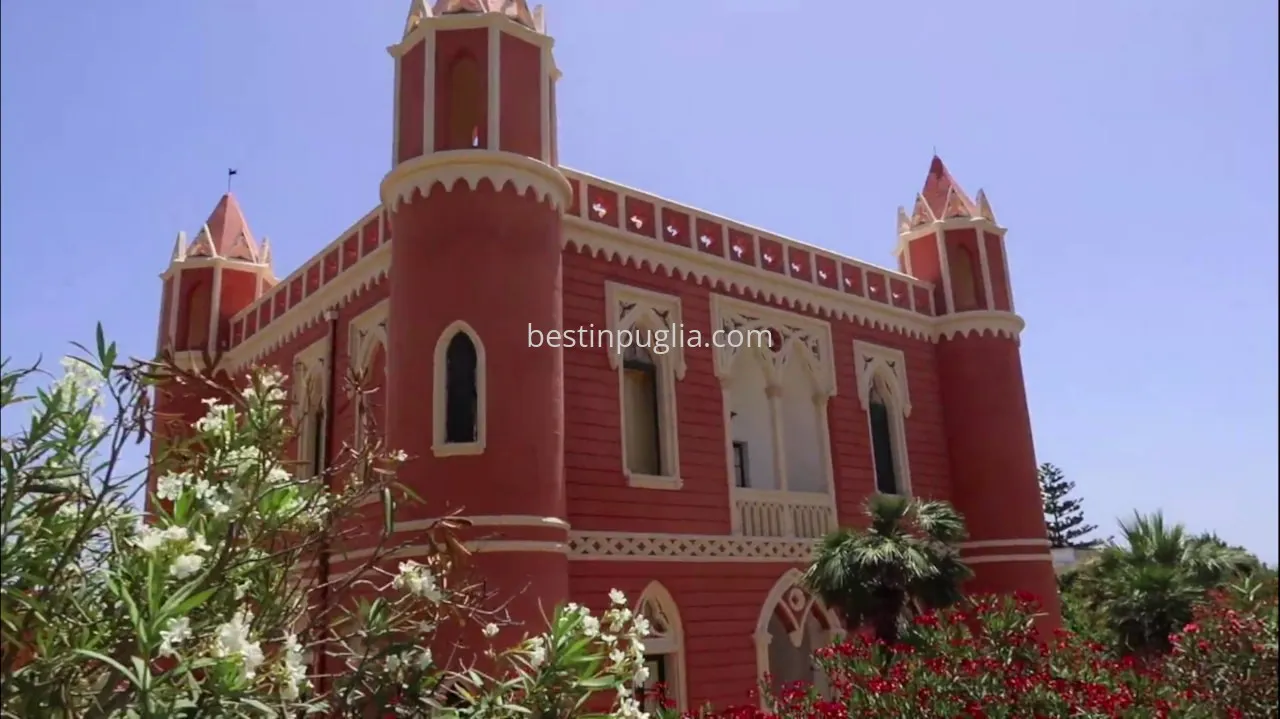
The historic villas of Santa Maria di Leuca are nineteenth-century villas built along the Leuca coast by nobles, aristocrats, artists or wealthy merchants of the time, with the aim of spending holiday periods near the sea and surrounded by nature. The villas, around 50, are located along the coast and many of these are open to the public for visits.
Each Villa in Santa Maria di Leuca usually has a park in front of the villa, with a tree-lined avenue leading up to the main entrance door.
In the rear part of the main building of the villa there is a garden which is also used to produce fresh fruit and vegetables.
Also in the back of the villa there is often a private chapel.
Inside the Villa there is historically a well for collecting drinking water, a stable for horses and a carriage house, which over time have been converted into habitable structures.
A very particular feature of some nineteenth-century villas of Santa Maria di Leuca, especially those closest to the coast, is that they were equipped with huts by the sea, on the cliff of the "capanni", which contained a tub where you could bathe with the sea water.
The huts were often built in the same style as the villa and were used by noblewomen to hide out while they bathed during the summer months.
Sanctuary of Santa Maria de Finibus terrae
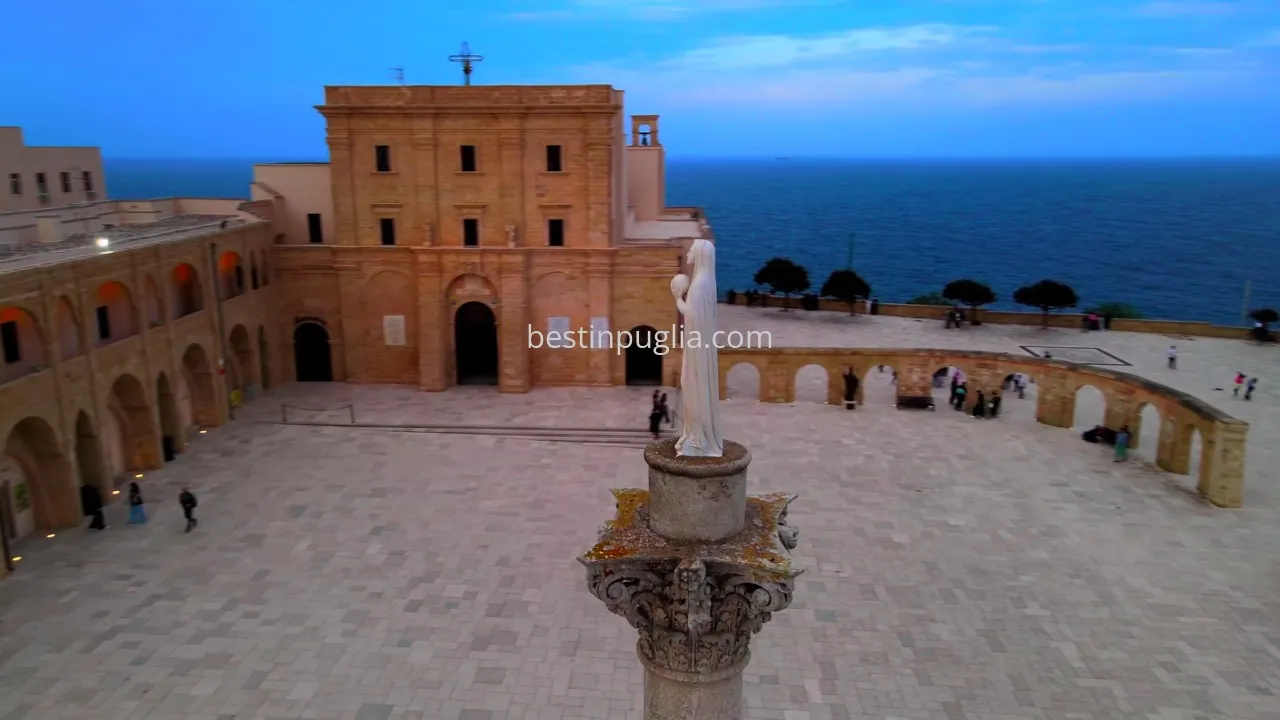
The basilica of Santa Maria de Finibus terrae is not only a symbol of the surrounding places, but the fulcrum of their millenary history. The name itself underlines the importance of the place, located on the promontory that marks the end of the Italian peninsula and separates the Ionian and Adriatic seas.
It is located on the tip of the Italian peninsula, where it was thought in ancient times that the emerged lands ended, becoming a point of reference for the entire territory. The first church was built here at the dawn of Christianity, on a pagan temple dedicated to the goddess Minerva.
Over the centuries, the sanctuary suffered repeated destruction and looting by the Turks and Saracens, but the current basilica was built in the 18th century, which still today retains many traces of the past within its austere walls.
Church of Cristo Re
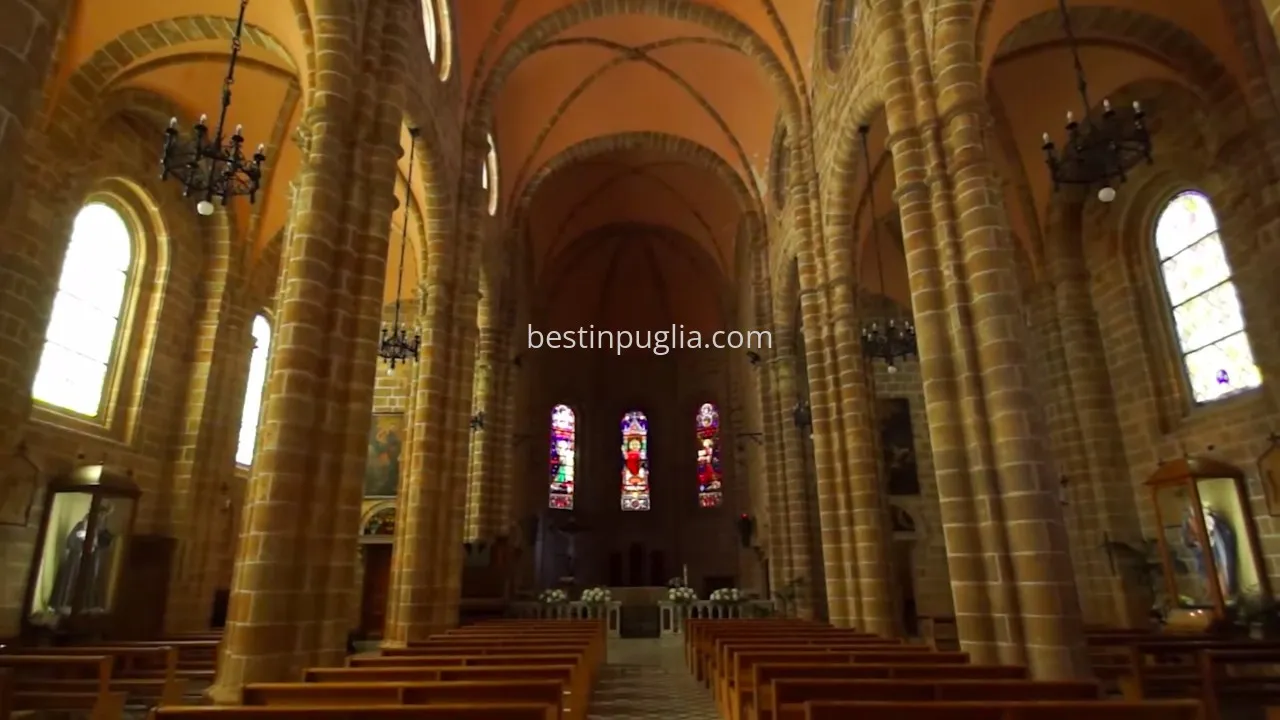
The church of Cristo Re is located in the heart of Marina di Leuca, a stone's throw from the seafront. It is a fine example of 19th century architecture in Lecce carparo, designed by Pasquale Ruggeri, an engineer who designed numerous noble villas in the area.
The church follows the canons of Lecce Gothic and has a façade with a pronaos of four columns with Corinthian capitals, a large rose window and a majestic cross. The interior is characterized by simple architecture, austere but of great impact, with large windows and circular windows and a mosaic floor with linear designs.
Vito Mele Museum
The Vito Mele Museum is located in the premises next to the basilica of Santa Maria de Finibus terrae. Inside completely restored ancient rooms there is a precious collection of sculptures by Italian and international artists, divided into historical masters and contemporary artists.
Among the most important names are Giò Pomodoro, Giovanni Conservo, Medardo Rosso, Floriano Bodini, Oreste Quattrini, Eros Pellini, Gaetano Martinez, Armando Marrocco and many others.
The museum, created by the will of the famous Salento sculptor Vito Mele, is located in a suggestive setting. Mele worked for important companies in the artistic metalworking sector and met important protagonists of the international scene who then inspired him in his sculptural activity, after leaving his beloved Puglia as a teenager to move to Lombardy.
Omomorto tower
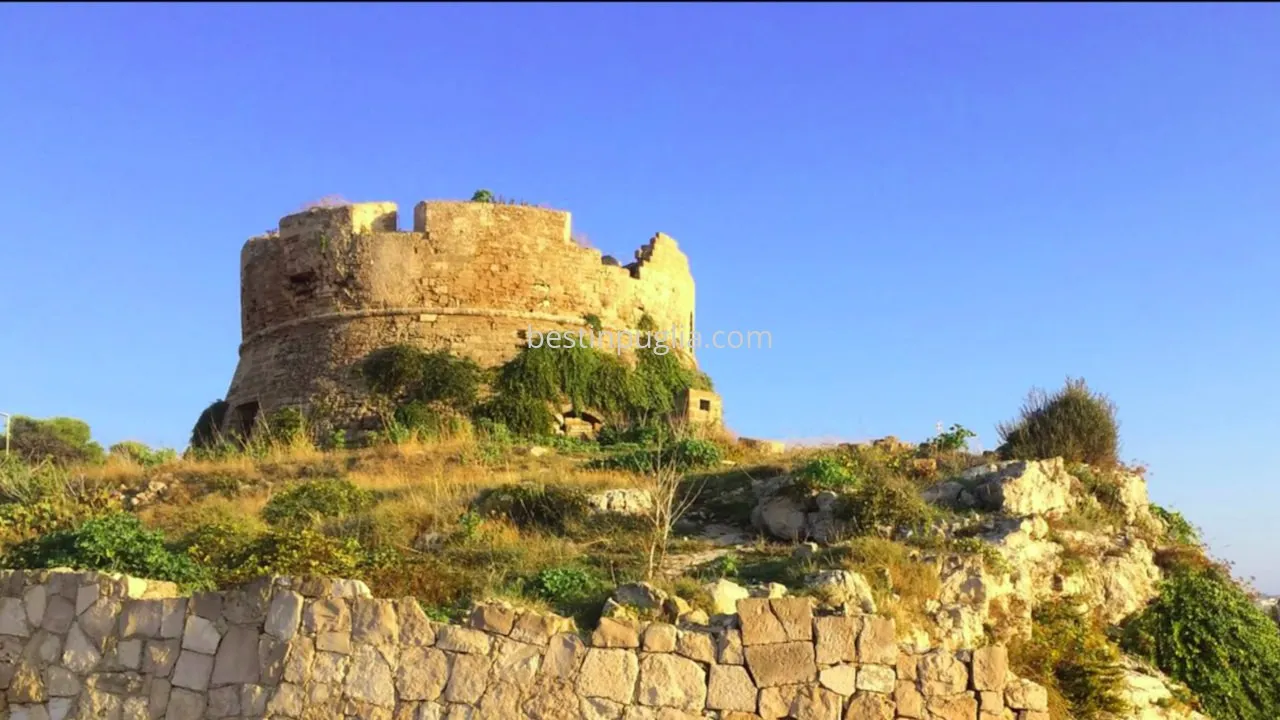
The Omomorto Tower, also known as the Old Tower, is located just 50 meters from the sea, on top of a promontory that offers a panoramic view of the entire coast.
Dating back to the 16th century, the tower once communicated with the nearby Marchiello tower and Santa Maria di Leuca tower and was an important defensive bastion for centuries.
Today, unfortunately, the tower is abandoned and in danger of collapse, but it is still famous for its considerable size: the base has walls almost five meters thick and a diameter of 16 metres.
Experts define it as an atypical tower, but certainly one of the most iconic and photographed places in this region.
Capo Santa Maria di Leuca Lighthouse
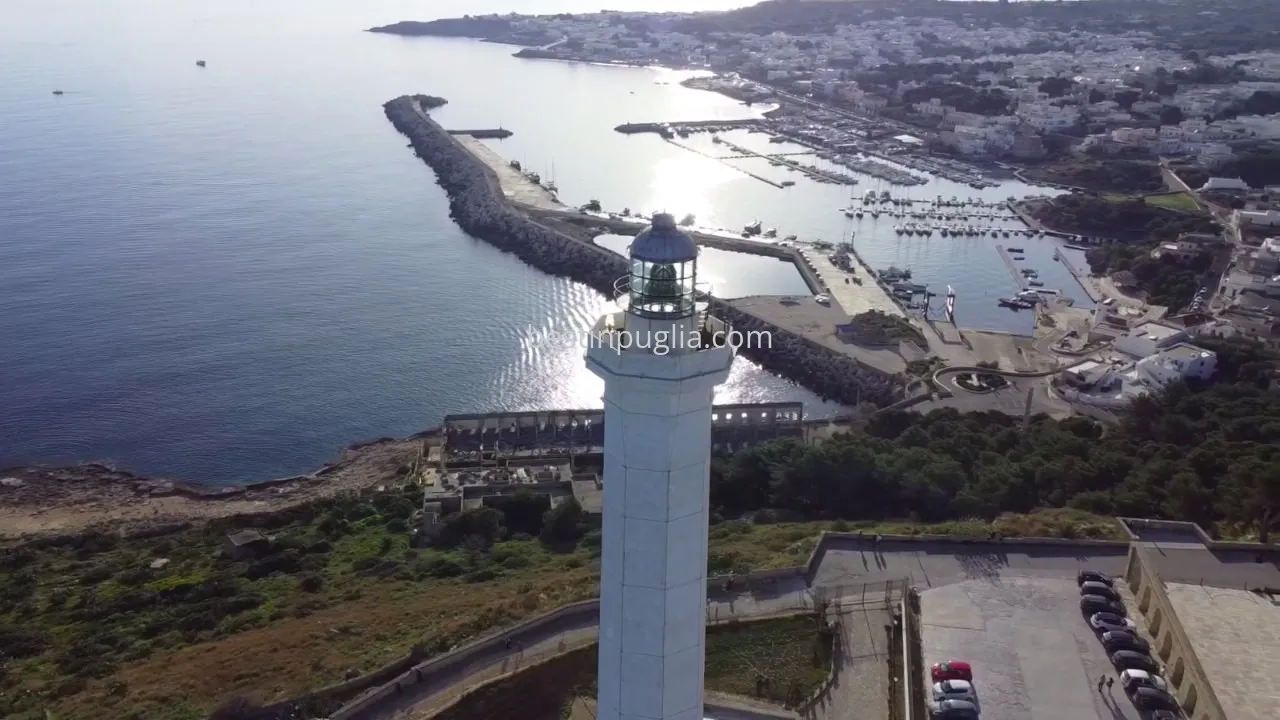
On the top of Punta Meliso stands one of the tallest lighthouses in Europe and one of the most beautiful in the whole of Italy.
The Leuca Lighthouse, built in 1864 to a design by the engineer Achille Rossi, stands where a watchtower once stood, not far from the large square in front of the sanctuary of Santa Maria. 47 meters high, the Faro di Leuca rises over a hundred meters above the waters of the sea.
Today, it can be visited by appointment and allows you to climb its 254 steps of a spiral staircase to reach the circular terrace at the top of the tower. From the top, you can enjoy a 360-degree panoramic view of the sea and the land, and, on a clear day, even the coasts of Greece.
Punta Ristola
Punta Ristola is the first panoramic point that one meets when coming to Marina di Leuca from Torre Vado-Gallipoli. Thanks to a recent renovation, it now offers a beautiful seafront with a breathtaking view of the sea, the cliff and the landscape of Leuca. Here, the scene is dominated by the imposing sculptures in Lecce stone by the artist Mario Calcagnile, including the evocative Triptych of Transcendence which depicts the swimmer of the two seas, the angel of Meliso and Leucasia.
At the foot of Punta Ristola you can visit the archaeological remains of Grotta Porcinara, an ancient Messapic, Greek and Roman place of worship, where there are inscriptions in various languages invoking divine protection. According to tradition, the Apostle Peter arrived here to begin evangelization in the West.
From Punta Ristola it is possible to admire the Tre Porte, the most photographed place in Leuca, where the waves break with spectacular majesty. Not far away is also the famous Grotta del Diavolo, known for its depth and the archaeological finds found there. All these natural beauties can be easily reached via a boat trip along the western coast of Leuca.
Punta Meliso
Punta Meliso, the extreme tip at the foot of the Leuca promontory where the Basilica and the majestic lighthouse stand, attracts tourists with its popular legend of the meeting of the two seas of Leuca. Many visitors believe that the currents of the two seas have a different tone and oppose each other, creating an optical phenomenon. But there is no scientific basis for this belief.
Despite this, the promontory of Leuca has always represented the crossroads of different civilizations and cultures, as demonstrated by the remains of the ancient fortified village dating back to the fifteenth-fourteenth century BC. which are located in the Punta Meliso area.
Today, the Punta Meliso area is part of the Costa Otranto - Santa Maria di Leuca and Bosco di Tricase Park, a protected area established by the Puglia Region to protect the beauty of the landscape, biodiversity and historical and archaeological beauties.
Furthermore, Punta Meliso is surrounded by numerous caves among the most beautiful in Puglia. The coast opens steeply into the cliffs which extend to the east and west of Santa Maria di Leuca, creating a unique and spectacular backdrop for anyone visiting the area.
Cascata Monumentale
The monumental waterfall of Santa Maria di Leuca rises on Punta Meliso and is the end of the Apulian aqueduct. The Roman column celebrates the completion of the works.
The monumental staircase, completed in 1939, fascinates with its beauty that is perfectly integrated into the surrounding landscape.
The engineers exploited the natural difference in height between the square of the Basilica and the lower part in front of the port of Leuca to create a unique architectural solution of its kind, full of charm and beauty!
The opening of the waterfall is a ritual that is renewed every time the water begins to flow gently down the slope towards the sea, with a deep meaning. Since 2015, artistic lighting moves in sync with music.
Grotta delle Tre Porte
The Grotta delle Tre Porte is one of the most famous and photographed caves of Leuca.
It consists of three large openings that reveal a vast cavity. Inside the cave, on the north wall, you can see a tunnel that leads to a large chamber full of stalactites and stalagmites, called Grotta del Bambino.
Here, the remains of an upper left molar of a Neanderthal boy of about 10 years old were found. In the tunnel, on the other hand, remains of rhinoceros, ancient elephant and deer were found.
What to see near Santa Maria di Leuca?
The villages, places and things to see near Santa Santa Maria di Leuca, distributed between the southern coasts and the countryside of Salento, are many and easily accessible.
The things to see closest to Santa Maria di Leuca are in:
- Giuliano
- Barbarano del Capo
- Patù
- Alessano
- Presicce
- Salve
- Morciano di Leuca
Giuliano
In the immediate vicinity of Santa Maria di Leuca is the village of Giuliano, which can be reached by crossing a majestic arch that leads to an enchanting maze of alleys, historic buildings and a 16th century castle with a moat.
Giuliano is a true jewel of Salento, which contains numerous historical and cultural treasures. Once through the entrance arch, you can stroll through the narrow cobbled streets of the historic center and admire the Baroque-style buildings and old churches, including the Church of the Madonna del Rosario and the Church of San Giovanni Battista.
The 16th century castle, with its imposing walls and moat, represents one of the most evocative symbols of Giuliano, and is an ideal place for a cultural visit and to admire the surrounding landscape.
In general, Giuliano is an ideal place for a relaxing walk and to discover the beauty and history of Salento, away from the tourist crowds. Do not miss the opportunity to visit this village during your stay in Santa Maria di Leuca.
Barbarano del Capo
In the vicinity of Santa Maria di Leuca is the municipality of Barbarano del Capo, where the complex of Santa Maria di Leuca del Belvedere is located. This place represents an important stop for pilgrims who travel along the Via Leucadense and stop there to find hospitality and refuge during their journey.
The complex of Santa Maria di Leuca del Belvedere, located in a panoramic and suggestive position, was built in Baroque style in the 17th century and consists of a church, a convent and a hospice for pilgrims.
Today the complex also houses a spirituality and formation centre, where it is possible to participate in retreats, prayer meetings and cultural activities.
A visit to the Santa Maria di Leuca del Belvedere complex represents an opportunity to discover the history and spirituality of Salento, and to immerse yourself in the beauty of the places that have made Puglia a land of great traditions and hospitality.
Patù
Near Santa Maria di Leuca is the municipality of Patù, where it is possible to visit various attractions of historical and archaeological interest.
The church of San Giovanni Battista, dating back to the 9th century, is one of the main places of worship in the municipality of Patù. The church has Romanesque architecture and preserves important works of art inside.
Among the other attractions to visit in Patù, there are the monument of the Hundred Stones and the ruins of the Messapian city of Vereto. The monument of the Hundred Stones, located in the main square of the municipality, is a singular construction made with stones of different shapes and sizes.
The ruins of the Messapian city of Vereto, on the other hand, represent evidence of the ancient civilization that inhabited the Salento area before the arrival of the Romans. Among the ruins, the foundations of the houses, the streets and the defensive fortifications are visible.
A visit to Patù represents an opportunity to discover the history and art of Salento, and to immerse yourself in the beauty of the places that have made Puglia a land of great traditions and millenary culture.
Alessano
If you are in the area around Santa Maria di Leuca, it is worth visiting the town of Alessano, famous for its medieval rock village of Macurano, considered one of the most important in the area.
Presicce
Near Santa Maria di Leuca is Presicce, an enchanting village which boasts the title of one of the most beautiful villages in Italy. Its historic center offers a splendid view of the palaces and hanging gardens that characterize this charming municipality.
Salve
If you are in the area around Santa Maria di Leuca, I suggest you pay a visit to Salve, where you can admire an underground oil mill, the room of the restored and functioning ancient looms, as well as the oldest functioning organ in Puglia in the Church of San Nicola . Furthermore, archaeological excursions are organized in the municipality along the gullies of the Fani, which will allow you to discover the beauty and history of the surrounding area.
Morciano di Leuca
If you are in the surroundings of Santa Maria di Leuca, you can stop in Morciano di Leuca. Here you can visit the sixteenth-century fortified district of Vico Torri, the church of San Giovanni Elemosiniere, the Castle, the Chapel of the Madonna of Constantinople with the frescoed Menir. Furthermore, walking through the courtyards of the neighborhood you can admire the architectural beauty of the place.
12 things to do in Santa Maria di Leuca
The sea, nature and the millenary history of Santa Maria di Leuca are the scenario in which every visitor can choose from many things to do, organized by the local community or in total autonomy.
There are many guides for hiking, scenic bike rides, boat trips, water sports, diving, fishing, guided tours of sea caves and many other activities, dedicated to outdoor enthusiasts.
Many visitors prefer to discover the area independently and for this reason they venture on the paths along the coast, or inland, to discover the panoramic points, the historical monuments, the caves, the sea and the breathtaking views of Santa Maria di Leuca.
Among the top 12 things to do if you visit Santa Maria di Leuca are:
- Coastal cave tour
- Days at the beach
- Activities at sea
- Panoramic tours
- Events and Festivals
- Wine tastings and local dishes
- Visit the Leuca Lighthouse
- Visit to the Sanctuary of Leuca
- Trip to the Monumental Complex of Leuca Piccola
- Stroll on the waterfront
- Tour of the nineteenth-century villas
- Excursions in the Regional Natural Park of Costa Otranto, Santa Maria di Leuca and Bosco di Tricase
Tour of Coastal Caves
The fascinating coastal caves of Santa Maria di Leuca offer a unique experience, immersing visitors in a natural environment of extraordinary beauty. Cave tours allow the exploration of hidden caverns along the coast, accessible only by sea, and provide an opportunity to discover a natural heritage that combines history and breathtaking landscapes.
Local tour operators organize guided boat tours, offering various options to explore this stretch of coast, famous for its unspoiled nature and striking rock formations.
To fully enjoy the natural light and reflection effects, the Levante caves, located on the Adriatic side, are particularly spectacular in the early morning, while the Ponente caves, on the Ionian side, show their best in the afternoon, when the low sun enhances the colors of the water and cliffs.
Access to the caves is only allowed through organized tours, as these caves are considered a protected natural heritage. Tourist agencies located near the Porto Turistico di Leuca and other nearby areas, such as Torre Vado, offer a wide range of options for boat rentals or guided excursions.
These excursions allow for a few hours of exploring fascinating places, immersed in a marine environment characterized by crystal-clear waters and towering rock formations.
The Ponente side, which stretches from Punta Meliso, near the Faro di Leuca, to the town of Ciolo, is known for its majestic cliffs that plunge into a sea of intense hues.
One of the most famous caves in this stretch is the Grotta Tre Porte, easily visible from the coastal road. This side is renowned for its wild beauty and rocky cliffs offering spectacular views.
Recommended caves of Ponente:
- Grotta Mesciu Scianni
- Grotta Fiume
- Grotta Titti
- Grotta Tre Porte and Grotta del Bambino
- Grotta del Presepe
- Grotta Stalla
- Grotta degli Innamorati
- Grotta del Drago
On the Levante side, rising towards the Ionian from Punta Ristola, is another of the most admired caves: the Grotta del Soffio, formed by the millennia-old action of the sea waves.
Considered one of the most beautiful caves in the area, it offers a suggestive experience thanks to the light effects and reflections created inside.
Recommended caves of Levante:
- Grotta Ruttedda
- Grotta degli Indiani
- Grotta Purraru
- Grotta Vardusedda
- Grotta Ortocupo
- Grotta del Soffio
- Grotta della Vora
- Grotta Le Mannute
- Grotta del Diavolo
Each cave has unique features, with stalactite and stalagmite formations, intense colors, and magical atmospheres created by natural light. Among the most requested excursions, the Levante and Ponente caves are must-visit stops for those exploring Santa Maria di Leuca, offering an unforgettable journey into a fascinating and wild underground world.
Grotta del Diavolo
The Grotta del Diavolo is of Neolithic origin, and its name derives from the powerful echoes heard inside during storms, which frightened sailors into thinking it was inhabited by the devil. According to legend, the devil hid among the rocks to terrorize navigators. In reality, the cave is a peaceful and suggestive place, perfect for admiring a breathtaking natural spectacle.
The cave has a wide opening that overlooks crystal-clear waters, offering a spectacular view of its rocky walls that rise majestically above the water. Inside, numerous stalactites and stalagmites can be observed, formed by the slow action of water dripping from the ceiling, creating light effects and reflections on the water that give the environment an almost magical atmosphere.
Grotta delle Tre Porte and Grotta del Bambino
The Grotta delle Tre Porte is one of the most famous and photographed caves in Leuca, thanks to its three large openings leading to a vast internal cavity. Inside, on the north wall, there is a tunnel that leads to a large chamber rich in stalactites and stalagmites, called Grotta del Bambino.
This cave is of great archaeological interest: inside, a molar from a Neanderthal child about 10 years old was found, along with the remains of animals such as rhinoceroses, elephants, and deer.
Grotta del Drago
The Grotta del Drago gets its name from the particular shape of the main cavity, which resembles that of a dragon. It is a place of great natural beauty and historical significance, used in the past as a refuge by fishermen and pirates. The interior of the cave is characterized by a large hall with stalactites and stalagmites of various shapes and colors. In addition to its naturalistic interest, the cave also holds sacred importance, having been a prehistoric place of worship.
Today, the Grotta del Drago is a very popular destination among tourists, especially for snorkeling and diving enthusiasts, thanks to its crystal-clear waters and the wonders it offers.
Days at the beach
Come and enjoy the sun and discover the beaches of Santa Maria di Leuca and some of the most beautiful beaches in Salento. In the area of Santa Maria di Leuca (from Leuca to Pescoluse, passing through Felloniche and Torre Vado) you will find, for example, the beach of Punta Ristola, Caletta del Ciolo, Felloniche beach, Pescoluse beach and Torre Vado beach.
During your stay in Santa Maria di Leuca you can easily move around Salento or visit some of the most beautiful beaches in the province of Lecce, all easily reachable from Leuca. Among these you will find the beaches of Gallipoli, the beach of Porto Selvaggio, the beach of Torre dell'Orso and many others.
The most beautiful trips to visit if you are in Santa Maria di Leuca are:
- Punta Ristola beach
- Cove of Ciolo
- Felloniche beach
- Pescoluse beach
- Torre Vado beach
During your stay in Santa Maria di Leuca you can easily move around Salento or visit some of the most beautiful beaches of Lecce, all easily reachable from Leuca. Among these you will find the beaches of Gallipoli, the beach of Pescoluse, the beach of Porto Selvaggio, the beach of Torre dell'Orso and many others.
Activities at sea
The sea that surrounds the promontory of Leuca is the protagonist in the daily life of the citizens and visitors of Santa Maria di Leuca.
The natural and scenic territory of Santa Maria di Leuca acts as a divider between the Adriatic Sea and the Ionian Sea, which join at Punta Meliso. Here you can live an unforgettable underwater experience with diving on the coast or in one of the many caves that can be visited.
Fishing enthusiasts can take part in one of the many organized fishing tourism trips. With Pescaturismo you can enjoy a day on a boat fishing with the help of local fishermen, on a boat equipped with everything you need, with a breathtaking view of the Santa Maria di Leuca area and the open sea.
If you want to spend a quiet day on the boat admiring the sea caves then you can take part in one of the many guided boat tours.
Renting a kayak or a canoe is instead a way to have a unique point of view of Santa Maria di Leuca and to be able to dive into some of the most unreachable and most beautiful points of the coast.
Panoramic tours
One of the best ways to spend your days in Santa Maria di Leuca is to participate in the panoramic tours organized by specialized guides and local tour operators.
Depending on your preferences you can participate in characteristic itineraries of the hinterland, between historical paths and trails, those on the coast, to admire the breathtaking maritime landscapes and some of the caves, or you can enjoy the landscape from the sea, independently or with one of the many tours organized.
On land you can take part in one of the traveling tours, on foot, by bicycle or on horseback. Usually the necessary for the tours is provided by the tour operators or by the guides who will accompany your experience, but you can certainly use your own equipment.
You can also rent bicycles or other means of transport to organize your own panoramic tour and enjoy Capo di Leuca in your own way.
If you decide to take a panoramic tour by sea, however, you can choose between different solutions, even combining some of them, according to your needs.
You will be able to explore the beauties of Santa Maria di Leuca in exciting tours lasting a few hours by boat, kayaking and snorkeling among the most important cliffs and caves.
With a boat tour you will admire the division of the seas and the lighthouse, coast the most beautiful caves and coves in the area and you can also do it in the exciting light of the sunset.
During the stops of the panoramic boat tours you can snorkel, usually with equipment made available to the guides, to explore the caves from inside.
You can also take canoe tours, visiting various caves from inside and alternating fishing and snorkelling moments.
The guides and tour operators will be available to provide the necessary equipment, and sometimes even food and drinks to refresh yourself during the tour hours. The tourist guides will accompany you in every phase of the adventure in order to guarantee you a safe, pleasant and full of surprises journey.
Event and Festivals
One of the best ways to spend your holiday in Santa Maria di Leuca is to immerse yourself and let yourself be carried away by the joy and poetry of the local events, festivals and fairs, in harmony with the locals and other visitors.
Participate in popular and patronal festivals, taste the typical products at the festivals of nearby towns and celebrate at festivals with different musical genres, immersing yourself in the tradition and culture of Salento.
Here are the most important events during the year in the area of Santa Maria di Leuca:
- Patronal feast of Sant'Ippazio in Tiggiano on 19 January
- Feast of San Gregorio in Acquarica del Capo on 20 January
- Candlemas Festival in Specchia on February 2nd
- San Marco Fair in Ruffano on 25th April
- Feast of Sant'Antonio in Tricase on 11 June
- Feast and Festival of San Luigi in Presicce on 21 June
- Fair of the SS. Peter and Paul in Tricase on 29 June
- Feast of the Madonna del Carmine in Presicce on 15th July
- Sagra te lu Paniri in Miggiano on July 16th
- Wheat Festival in Acquarica del Capo on July 26th
- Puccia festival in Ugento on July 28th
- Sagra te li Ciceri e Tria in Ugento on 4th August
- Ficandò festival in Alessano at the beginning of August
- Feast of San Vito in Tricase on 9 August
- Sagra dei Piatti Nosci in Castrignano del Capo on 11 August
- San Vito fair in Presicce on 11 August
- White Night in Specchia on 12 August
- Feast and Fair of San Rocco in Ruffano on 15th August
- Sagra Manciata and Ballata in Patù on 18 August
- Fried Fish Festival in Castrignano del Capo on 18 August
- Feast of the SS. Hello doctors on 27 September
- Pork Festival in Miggiano in mid-October
- Fair and Feast of Santa Lucia in Tricase on 13 December
- Pittula festival in Tiggiano on 21 December
- Pittula festival in Specchia 24 December
- Living nativity scene in Tricase on December 25th
If you want detailed information to organize your participation in events, festivals, patronal feasts or music festivals, we recommend that you contact the organizers of the individual events, local associations or the municipalities of the individual localities where the events take place.
In any case, once you arrive in Santa Maria di Leuca you can go to one of the many information points distributed throughout the area to get all the information you need to get your bearings and to reach the events you would most like to visit.
Wine tastings and local dishes
If you are in Salento you cannot help but taste the wines and typical local products if you participate in one of the many events held in the area throughout the year.
If you are passionate about wines and good local gastronomy, typical Mediterranean cuisine, then in Santa Maria di Leuca you are in the right place!
You will find a wide choice of local producers with farmhouses, farms or restaurants where you can try authentic food and wine experiences that will enrich your holiday in Puglia.
The Apulian food and wine offer in general is renowned for its authenticity and high quality, offering the best for guests and visitors.
During each experience you will be greeted by warm and welcoming staff who will accompany you inside the facilities making you feel at home.
As guests you will be able to discover the secrets of the local winemaking and gastronomic activities guided by the knowledge and traditional methods of the establishments in which you will be served.
Many of the food and wine events are organized directly in wineries or cellars, which welcome visitors to their companies with tours and tastings of their products.
Other appointments with wines and typical products are held in very particular locations such as for example in vineyards or olive groves, within typical structures such as Trulli or ancient Masserie.
Some companies instead offer home delivery services of fresh or cooked products, together with good local wine, directly where you are staying and at the time you prefer. You can ask the local businesses and shops if they offer this type of home service.
Take part in an unforgettable visit to one of the wine cellars of Santa Maria di Leuca in Puglia to experience some of the authentic, lived and suggested experiences.
In all the seaside resorts in Santa Maria di Leuca, in the historic villages or in the surrounding countryside you can always find inns, bars, refreshment points. Everywhere you can have an aperitif and taste typical Apulian products such as cured meats, cheeses, bread, taralli, olives and many other typical delicacies of Salento.
€ 950
€ 35
€ 30
Visit the Leuca Lighthouse
The lighthouse of Santa Maria di Leuca is one of the most beautiful places on the Salento peninsula and the second highest lighthouse in Europe after the one in Genoa. It rises near the Basilica Sanctuary of Santa Maria de Finibus Terrae and has an octagonal shape of 47 meters and a height of 120 meters above the sea.
The lighthouse was designed by the engineer Achille Rossi in 1864 to replace an older 13th century structure built by Frederick II of Swabia. Opened in 1866, the lighthouse has been a landmark for mariners from Africa and the Middle East for decades.
The lighthouse of Santa Maria di Leuca can be visited by reservation on special occasions and the spiral staircase leading to the top is made up of 254 steps. Once you arrive, you can admire the sea and the coast from the circular terrace and the lantern, with a diameter of about 3 meters, emits beams of red and white light visible over 50 km away.
From the top of the lighthouse of Santa Maria di Leuca you can enjoy an incredible panorama of the Greek coast, with the possibility of seeing the island of Corfu and the chain of Acrocerauni Mountains on the border between Greece and Albania. But the real show is the line that separates the two seas, the Ionian and the Adriatic, a very rare phenomenon that can be admired only in a few other parts of the world.
Santa Maria di Leuca is an exclusive destination also for this natural wonder. When weather conditions permit, the clear division and the different colors of the colliding waters create a unique spectacle that enchants locals and tourists.
This magical place has an ancient belief that placed it as the most remote edge of the Earth. This legend is reflected in the toponyms of the area, which have very ancient roots.
Visit to the Sanctuary of Leuca
At the end of the Via Francigena, next to the Leuca Lighthouse, is the Basilica Santuario Santa Maria de Finibus Terrae.
The Basilica Sanctuary of Santa Maria de Finibus Terrae is located on the top of the promontory of Punta Meliso, in Salento.
This place represents one of the most important landmarks of Christianity in the area.
The origins of the basilica are very ancient and surrounded by legends, traditions and faith that are intertwined with historical events.
According to tradition, an ancient temple dedicated to the goddess Minerva once stood in this place, of which certain traces have not yet been found by archaeologists.
However, inside the basilica there is a monolithic cippus which has always been considered what remains of an ancient pagan altar, the Ara a Minerva.
According to tradition, the Apostle Peter would have built a new church in place of the old temple, dedicating it to the Savior (43 AD).
Unfortunately, during the period of edicts against the Christians, the church suffered the consequences and was razed to the ground along with other places of worship.
In the 4th century it was rebuilt and dedicated to the Madonna thanks to the passage of Pope Julius I who also granted plenary indulgence to anyone who visited Leuca. Since then, the cult of the Madonna di Leuca was born with a miraculous event that saved a group of fishermen during a storm.
The history of the basilica has been characterized by destruction and reconstruction, but the sanctuary that we admire today is the result of the last reconstruction which took place in 1700 by Bishop Giannelli.
The Basilica Santuario Santa Maria de Finibus Terrae stands majestically in the center of the square with a colonnade overlooking the sea, like an imposing fortress.
Trip to the Monumental Complex of Leuca Piccola
The complex of Santa Maria di Leuca del Belvedere (Leuca Piccola) is a 17th-century structure that includes a chapel with 18th-century paintings, cellars, stables and a market area with arches and a decorated portal.
These spaces were intended to welcome pilgrims traveling to the Sanctuary of Santa Maria di Leuca, coming from northern Italy, Puglia and northern Europe, who stopped in Barbarano to rest before their final destination.
To promote the municipal area to a wider public, initiatives have been launched to raise awareness of the monumental complex of "Leuca Piccola" and the nearby karst ravines called "vore".
These attractions are part of a tourist card which includes itineraries to visit the historic centers of Barbarano del Capo, Morciano di Leuca and the marina of Torre Vado. The aim is to attract tourists not only during the summer season, but also outside the tourist season.
The complex of "Leuca Piccola" offers many things to see, together with other cultural and naturalistic treasures of the surrounding area. Visiting it also allows you to discover the beautiful village of Barbarano del Capo and its surroundings.
The cultural and tourist promotion of the region is an important source of social, civil and economic development for the local community, and this provides various opportunities for visitors to experience the traditions and culture of the Santa Maria di Leuca area.
Stroll on the waterfront
Walking along the Lungomare is a romantic and unforgettable experience in any seaside resort, but doing it in Santa Maria di Leuca is a unique experience.
The Via Japigia is a long coastal road that starts from the SP91 and extends up to the Sanctuary of Santa Maria di Finis Terrae.
This elegant promenade dotted with large palm trees offers a spectacular view of the beach, the rocky cliffs and the port. Thanks to the continuous balcony, you can enjoy a breathtaking panoramic view.
Along the seafront path in Santa Maria di Leuca there are hotels, restaurants and clubs to spend pleasant hours admiring the Salento panorama
At sunset, the promenade takes on a particular charm and the Samarinda bar is a great place to enjoy it with an aperitif overlooking the sea.
We recommend a stop at the small ice cream parlor at the beginning of the promenade after the port, where you can buy excellent homemade ice cream to enjoy during the walk.
Tour of the nineteenth-century villas
Santa Maria di Leuca, set in the rock and embraced by the sea, is a jewel also for its villas, each one unique in style and particularity, each steeped in history.
Browsing through the history and beauty of these villas means discovering places and structures that are part of the cultural heritage of Santa Maria di Leuca.
There are so many ancient villas to visit and each of them is characterized by its own style and has its own peculiarities. Some of these villas are not only open to the public. In some of these villas it is even possible to stay, booking well in advance, or enjoy an aperitif or dinner in a unique setting.
The first villa with a garden was that of Baron Romasi. In 1868, in Santa Maria di Leuca there were ten villas in the marina, which became fifteen the following year, twenty in 1876 and even forty-four within a few years.
All the villas seem to compete for the primacy of beauty, with land exposed to the sun and the background of the Japigio promontory.
The first sixteen villas of Santa Maria di Leuca were all in the Tuscan style, but did not have particular decorations, as the architects worked on widespread models. In 1874 the villas took on a new face, with styles ranging from Ionic to Gothic, from French to Pompeian, from Risorgimento to Moorish, Arabic and Chinese.
The main architects who participated in the construction of the villas were G. Ruggeri, Carlo Arditi and Achille Rossi. A villa worthy of respect must have the family church, a well, a large garden with pines and palms, framed by the greenery of the Mediterranean scrub.
Every May, the "Ville in Festa" event takes place in Santa Maria di Leuca, where the gardens of the most beautiful villas in the city and on the Lungomare Cristoforo Colombo are open to the public. An opportunity to discover eclectic architecture from the 19th and 20th centuries. There are also art exhibitions, tastings, screenings and fashion shows.
Participating Ville in Festa include: Villa Pia, Villa Cezzi, Villa Circolone, Villa Sangiovanni, Villa Felicita, Villa Mellacqua, Villa Arditi di Castelvetere, Villa Licci, Villa Ramirez, Villa Gioacchino Fuortes, Villa Fuortes, Villa La Meridiana, Villa Colosso , Villa Daniele, Villa Episcopo, Villa Serracca, Villa Tamborino-Cezzi, Villa Arditi, Villa Marcucci and Villa Scipione Sangiovanni.
Excursions in the Otranto-Leuca-Bosco Tricase Regional Park
The Costa Otranto - Santa Maria di Leuca and Bosco di Tricase Regional Natural Park offers enthusiasts fantastic routes for trekking and excursions. The park is really vast and offers several unique glimpses of the sea and ancient monuments that can be discovered along the paths.
The Otranto-Leuca Regional Natural Park is an ideal destination for trekking lovers.
Walking towards Capo di Leuca is an unforgettable experience, thanks to the breathtaking natural views of the sea, the centuries-old olive groves, the rural buildings and the ancient villages that you meet along the way. Don't miss the opportunity to experience this adventure to discover the beauty of Salento.
Below you will find some of the best routes in the Regional Park for excursions and unforgettable walks.
Tratturi del Ciolo (3km)
The Ciolo Canyon and its prehistoric caves are one of the stops not to be missed and one of the shows that most fascinate visitors.
The path that connects the Ciolo to Porto Vecchio in Novaglie is easy and also suitable for children, with a duration of about an hour.
In ancient times this road was used by merchants to transport goods such as salt and fabrics from the coastal areas to the inland areas of Salento.
Path of the Cipollian Caves (3km)
The Sentiero delle Grotte Cipolliane offers an easy and suggestive route that ends with a visit to the splendid caves of the same name.
The 2.5 km of the Cipolliane path are within the reach of trekking enthusiasts.
Even the less trained, but used to long walks in nature, can complete the route in about an hour.
The South East Track (83km)
The multi-route itinerary La Traccia Sud Est leads visitors to discover the Adriatic coast of Salento in the Otranto-Leuca Regional Natural Park.
The South East Track is the longest trekking excursion on sheep tracks in Salento, but also the most original and suggestive for the landscape and naturalistic panoramas it offers.
Between the beauty of the Adriatic sea and the ancient rural territory, this route offers a unique experience with a series of breathtaking landscapes and settings.
Ancient path of Mannuta (5km)
The Mannuta path in Gagliano del Capo offers breathtaking views of the Adriatic coast, with lush vegetation and unspoiled nature.
Along the east coast of S.M. di Leuca, the high cliffs of Salento overlook the dark sea, telling the story of the area and bearing witness to geological times.
On a cliff hidden from the coastal road, it reveals all its splendor only from the waters of the surrounding sea, which have shaped its shape and appearance for millennia.
Paths of the Salt Roads (6km)
Immerse yourself in the history, tradition and breathtaking views of Mediterranean nature in a place that holds a wide range of plant and bird species.
The Sentiero di Funnu Vojere in Corsano offers a varied route that includes difficult sections with gradients that the path follows carelessly, hopping among the shrubs.
Among cliffs, terraces and paths overlooking the Adriatic, you can discover hidden pools where salt, often smuggled, was treated.
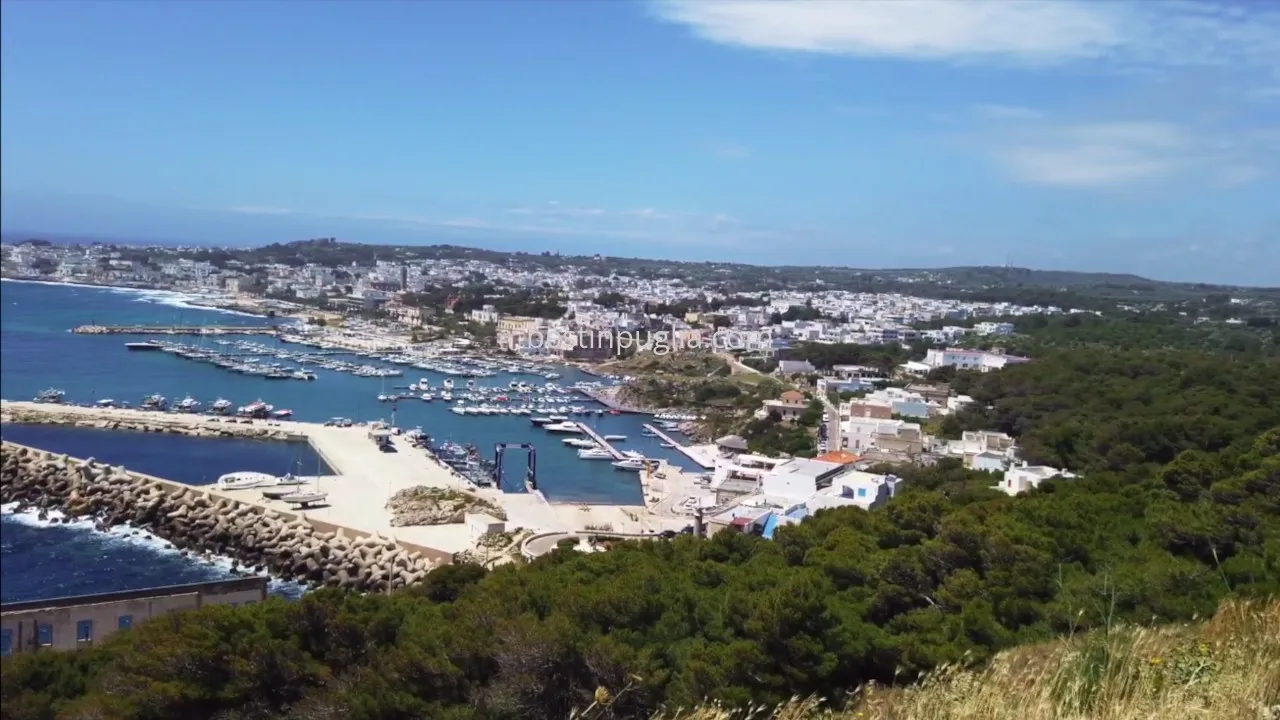
What to do near Santa Maria di Leuca
Participate in local experiences
Take part in experiences, food and wine itineraries, cultural events, guided tours or light trekking in the area of Patù, Morciano, Presicce, Giuliano and Castrignano. Enjoy a pleasant walk among the suggestive dry stone walls, discover the ancient farms of Capo di Leuca and taste some of the best wines of Puglia.
Visit local Feasts, Sagre and Festivals
Participate in popular and patronal festivals, taste the typical products at the sagre of nearby towns and celebrate at festivals with the best music of the moment, immersing yourself in the tradition and culture of Salento.
Trip to Otranto
Do not miss the opportunity to visit the splendid city of Otranto, along the panoramic coastal road Santa Maria di Leuca-Otranto.
Guided tour of the Baroque of Lecce
Take part in a guided tour to discover the Baroque of Lecce, but be careful: a full day may not be enough!
Visit Gallipoli
Visit the beautiful city of Gallipoli, admiring the old part on the islet and enjoying the delicious seafood of the port!
What to do in the evening in Santa Maria di Leuca?
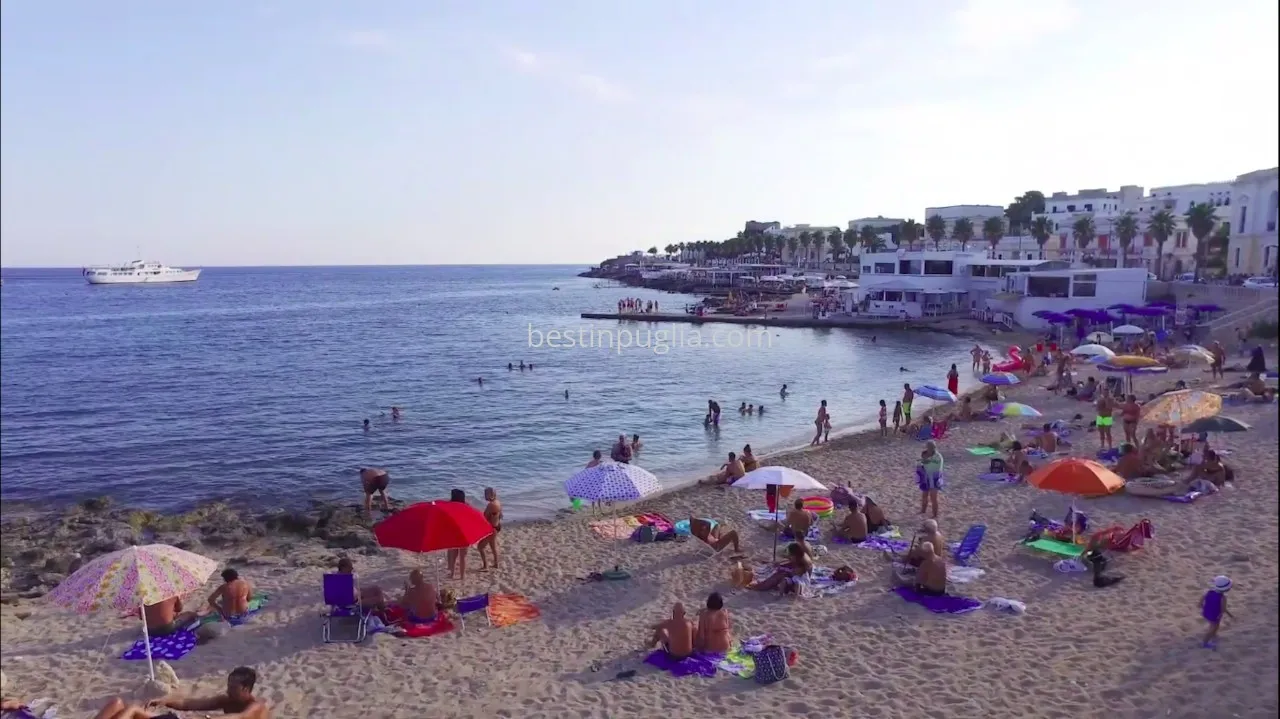
Santa Maria di Leuca is a very popular tourist resort during the summer, above all for its privileged position in the center of Capo di Leuca.
In the evening in Santa Maria di Leuca enjoy the sea breeze and the fantastic sunset. Especially during the summer you can stop in one of the many bars and clubs to enjoy aperitifs and dinners directly on the sea. Taking a holiday in Santa Maria di Leuca means enjoying the sea and relaxing.
The things you do in the evening in Santa Maria di Leuca are:
- Visit the waterfront
- Shopping, Gastronomy or Events
- Participate in Patronal or Seasonal Feasts
Visit the waterfront
Its seafront, known as Cristoforo Colombo, is the real pearl of the navy and runs along a splendid bay that goes from Punta Ristola to the area in front of the tourist port at the foot of Punta Meliso. Don't miss the opportunity to take an elegant walk and enjoy the breathtaking view, even if it is always pleasantly crowded in summer.
The seafront of Leuca is the beating heart of the town's nightlife. Here are the most exclusive lidos, which in the evening are transformed into refined venues where you can listen to good music. A suggestive pedestrian area, immersed in an elegant atmosphere, which becomes a place for meeting, strolling and romantic evenings under the stars. Furthermore, during the summer there are frequent special events and the artistic lighting show of the Monumental Falls of Leuca accompanied by musical notes.
Shopping, Gastronomy or Events
In Leuca there is no shortage of shopping and restaurant opportunities. Here you can find shops with the most prestigious brands, shops with typical local products or fine wines. Furthermore, cultural events, exhibitions and shows are held throughout the summer to enliven the evenings. Along the alleys there are also numerous trattorias, typical restaurants, sandwich shops and pizzerias very popular with young people.
Participate in Patronal or Seasonal Feasts
The feast of the Assumption and of the Madonna di Leuca, which is celebrated on August 15th, is the most awaited event by the local community. The tradition has very ancient origins and the local population participates with great enthusiasm in religious and civil celebrations. The sea procession with the statue of the Madonna is followed by a grandiose fireworks display over the sea, which makes the atmosphere even more magical and captivating. The August 15th festival is a moment of great joy and sharing for all the citizens and tourists who are in the area.
How is the sea in Santa Maria di Leuca?
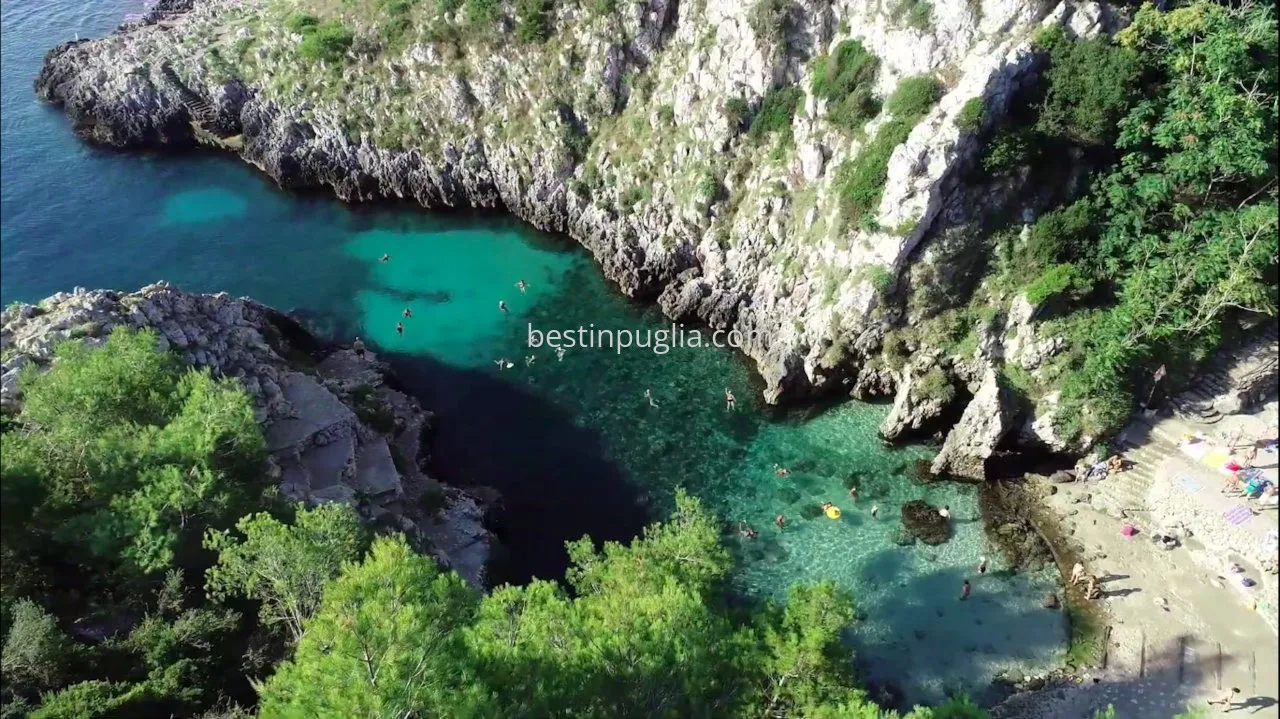
The sea in Santa Maria di Leuca is crystal clear. The rugged coast is characterized by rocky areas and sandy areas.
The part of the rocky coast is characterized by small coves and caves that you can visit by booking a boat trip.
Santa Maria di Leuca and the two seas
In Santa Maria di Leuca it is possible to visit some of the most beautiful stretches of coast in Salento. The area is characterized by the high and jagged coast, with the alternation of sandy beaches and coves where you can relax in the sun until sunset.
Punta Meliso, the extreme tip of Puglia where the Adriatic and Ionian meet
Punta Meliso, in Santa Maria di Leuca, represents the most extreme part of Puglia and forms, together with Punta Alice in Calabria, the Gulf of Taranto, or the gulf that opens onto the Mediterranean Sea between the regions of Puglia and Calabria.
At Punta Meliso, the Adriatic coast and the Ionian coast are separated by nautical convention.
But beyond the conventions, precisely at Punta Meliso, a clearly distinguishable separation line on the seabed between the two seas is sometimes visible in the sea, due to the currents that meet between the Otranto channel on the Adriatic Sea and the Gulf of Taranto on the Ionian Sea .
Santa Maria di Leuca Beaches
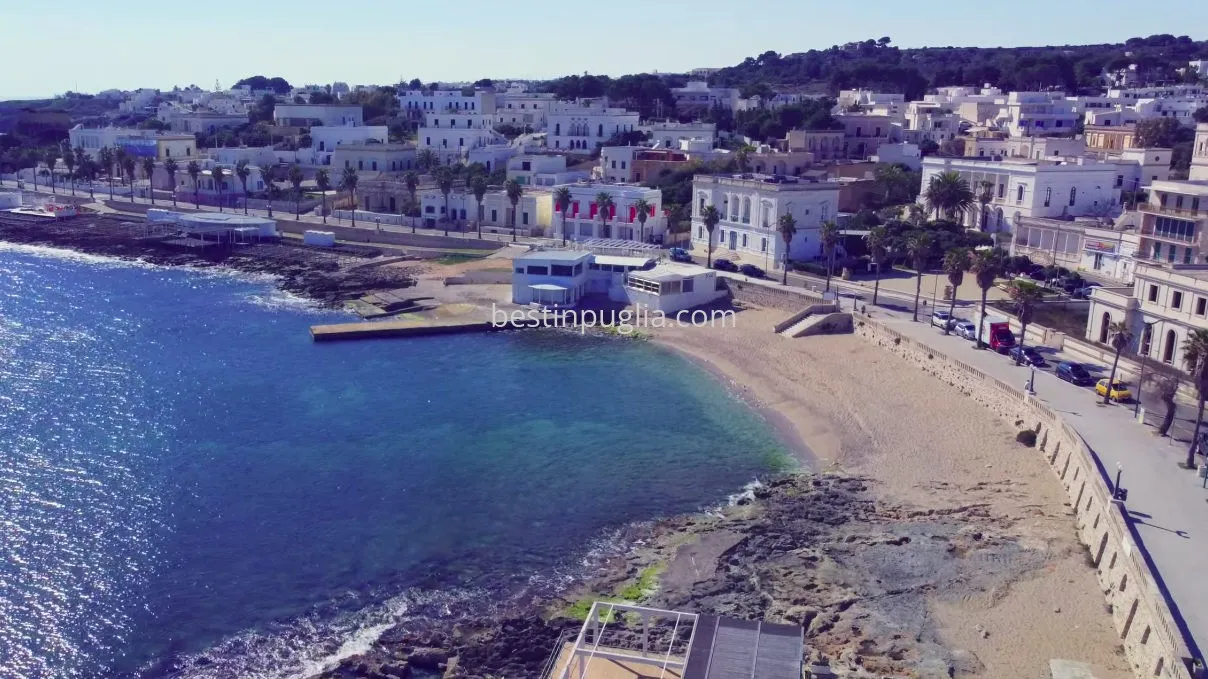
The Marina di Leuca offers a mainly rocky coast, interspersed with splendid sandy coves with crystal clear water.
Already on the seafront of the town of Santa Maria di Leuca overlooks a body of water with crystal clear waters, with shallow waters and comfortable landing places for the characteristic local bagnarole. Locals and vacationers spend their break hours, or moments of relaxation, a few steps from the house on the seafront.
In general, this whole area of Salento is ideal for sea and nature lovers, with many opportunities for snorkelling, diving and water sports.
The beaches of Santa Maria di Leuca are very varied: some are characterized by sandy beaches, while others are easily accessible thanks to slides and steps carved into the rock.
The entire bay of Leuca is bordered by modern lidos and bathing establishments, equipped with walkways and solariums, which offer easy access to the sea.
These places are perfect for relaxing and enjoying the sun and the sea in an atmosphere of absolute comfort.
The position of Santa Maria di Leuca is ideal for those who love variety: in a few minutes by car you can reach the sandy beaches of the Ionian side or the picturesque caves nestled between the cliffs of the Adriatic side.
Among the best beaches to visit in Santa Maria di Leuca you will find:
- Sandy beaches on the seafront of Santa Maria di Leuca
- Spiaggetta del Ciolo, the bluest sea in Leuca
- Felloniche beach
- Torre Vado beach
- San Gregorio Bay
- Pescoluse beach
Sandy beaches on the seafront of Santa Maria di Leuca
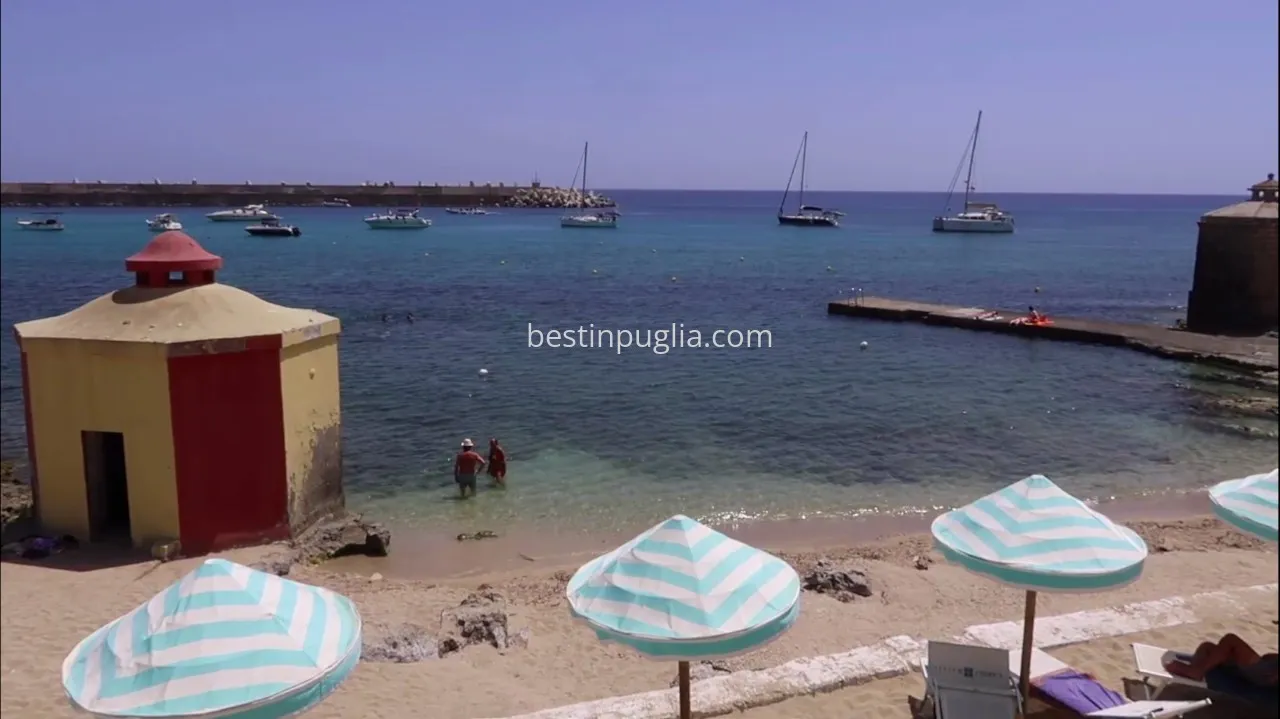
The sandy beaches of Marina di Leuca are easily accessible on foot from the city center and are the most popular from early in the morning until late at night.
Among the sandy beaches are the Lido Azzurro and the Hotel Terminal.
Lido Azzurro offers an equipped beach and a very popular place in the evening.
Do not miss the other beautiful sandy beach, bordered by the characteristic bathing houses of Villa Meridiana and Villa Fuortes.
During the night of August, the sandy beaches of Leuca are the ideal place to admire the fireworks.
Spiaggetta del Ciolo, the bluest sea in Leuca
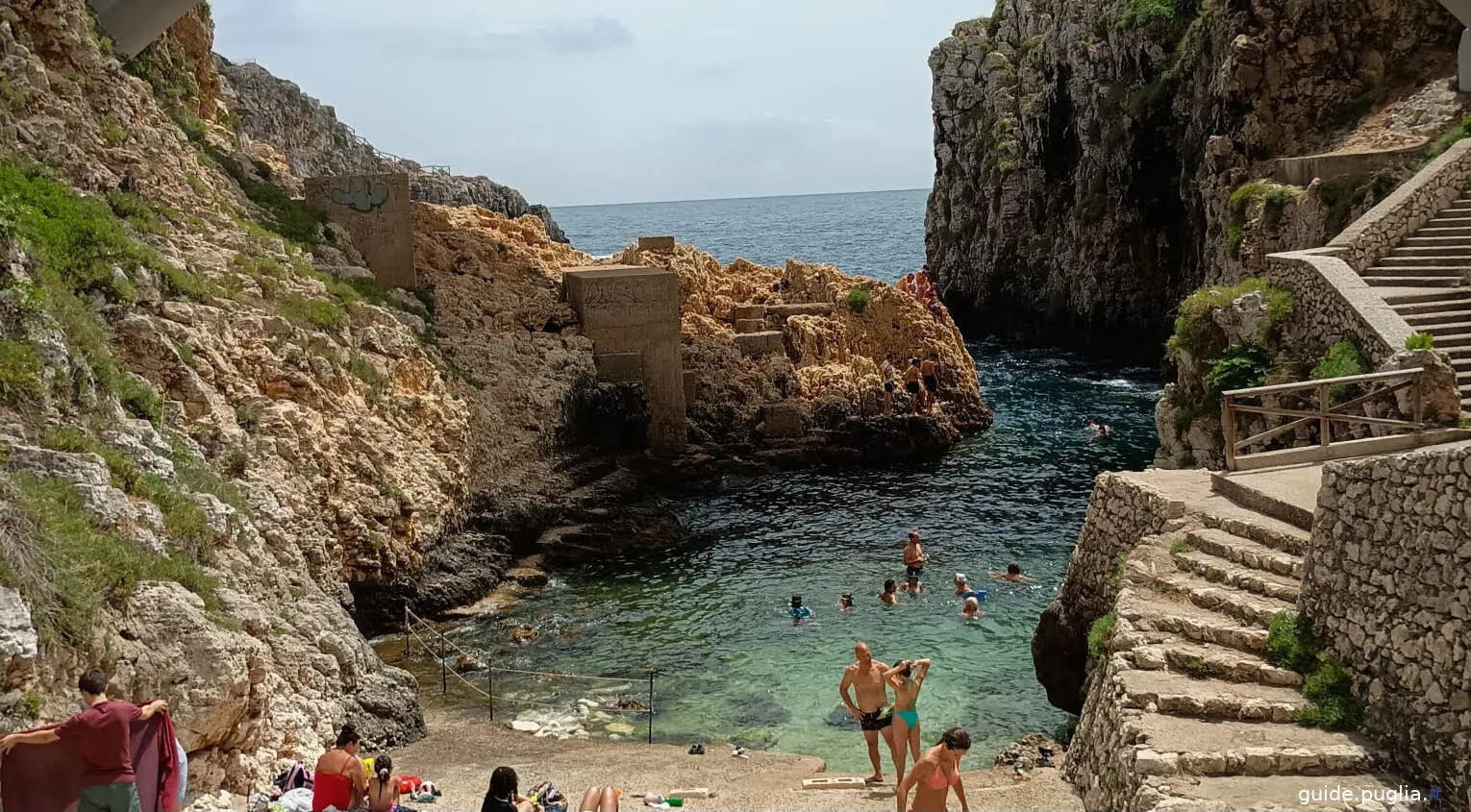
Discover the wonderful coast of Leuca and the Ciolo beach with the bluest sea! Located just 10 minutes by car north of Leuca, along the panoramic coast, the Ciolo locality offers a breathtaking tour through one of the most suggestive areas of Puglia.
Immerse yourself in a unique context by accessing the Ciolo beach, nestled at the foot of a large bridge that crosses the fjord, thanks to a staircase carved into the rock.
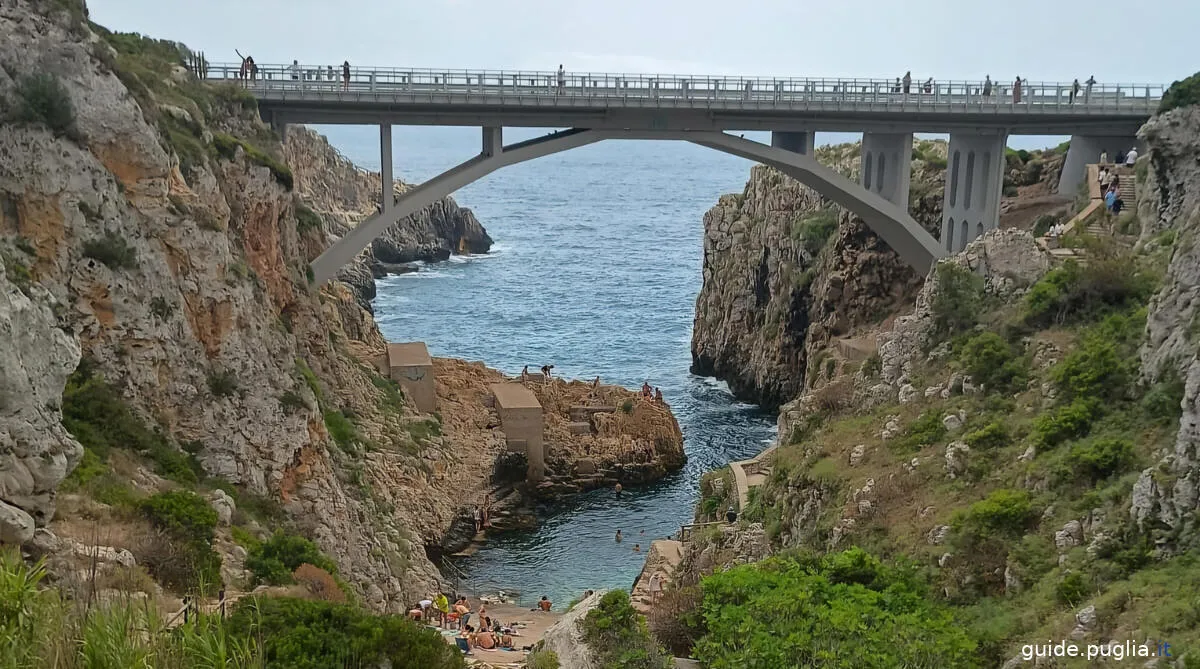
Don't miss the opportunity to enjoy romantic lunch breaks overlooking the sea, surrounded by cliffs and the scents of the Mediterranean scrub.
Explore the beauty of Leuca and its coast, and let yourself be enchanted by the Ciolo beach.
Spiaggia di Felloniche
Explore the wonderful Felloniche beach! The enchanting inlet, located just 5 minutes from Leuca and reachable from the coast road in the direction of Gallipoli, holds a strip of sand and a crystalline and calm body of water.
Luxury boats often choose to moor here to enjoy the sea. In the Felloniche area there are several well-served parking areas, both on the seafront and in the area near the roundabout, where parking is freer and easier to find.
In the water, for the entire summer season, you will also find floating inflatables with courses suitable for everyone and a water volleyball court. Felloniche beach is perfect for families with children and offers an unforgettable experience for everyone. Don't miss the opportunity to discover this hidden treasure of the Leuca coast!
Torre Vado beach
Explore the beautiful beach of Torre Vado, located just 10 minutes from Leuca! Following the panoramic coast, the landscape changes completely, leaving room for the colors of the characteristic dry-stone walls, red earth and prickly pears.
The marina of Torre Vado, a pretty town with its marina, offers a breathtaking view of the seafront that separates it from the nearby Posto Vecchio beach.
The beach of Torre Vado, located in front of the tower, is very busy from the first light of dawn. Yoga enthusiasts will find here the perfect place to regenerate, while new parents can treat their little ones to the beneficial effects of the sea breeze in the morning. Don't miss the opportunity to discover this pearl of Salento!
San Gregorio Bay
Explore the beautiful bay of San Gregorio! This ancient Messapian port, located a few steps from Felloniche, offers a unique immersion in the history of Salento. The low, rocky and easily accessible coast protects a small bay with crystal clear and clean waters, always crowded.
Access to the bay is via a single road that leads to the pretty terraced square overlooking the sea, where you can taste delicious dishes in the area's historic restaurants or enjoy an aperitif with music by the sea in the more modern place frequented above all by young people.
The presence of ancient monoliths on the terrace that slopes down towards the sea bears witness to the millenary history of San Gregorio, which was the port of the ancient Messapian city of Veretum. Don't miss the opportunity to discover this extraordinary place that will transport you back in time to the splendid setting of the Leuca coast.
Pescoluse beach
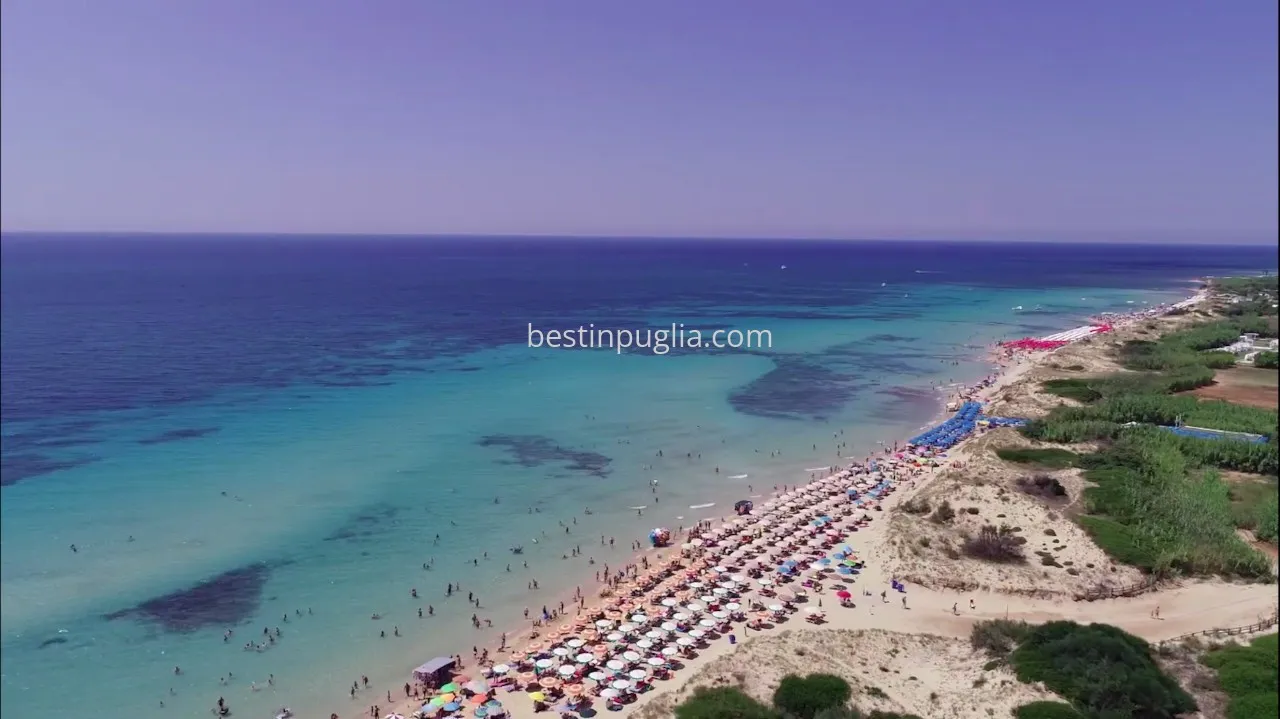
A few minutes from Santa Maria di Leuca you can reach the most famous beach of Capo di Leuca, the Pescoluse beach.
Its golden sand and crystal clear sea make it similar to tropical paradises. Pescoluse known in Italy and in the world as the "Maldives of Salento".
The beach stretches for miles of sand dunes and offers facilities for everyone, including ample parking.
You can easily reach it from Santa Maria di Leuca, following the coast road or state road to Gallipoli, together with all the other beaches, from Posto Vecchio to Torre Pali.
Holiday accommodation in Santa Maria di Leuca
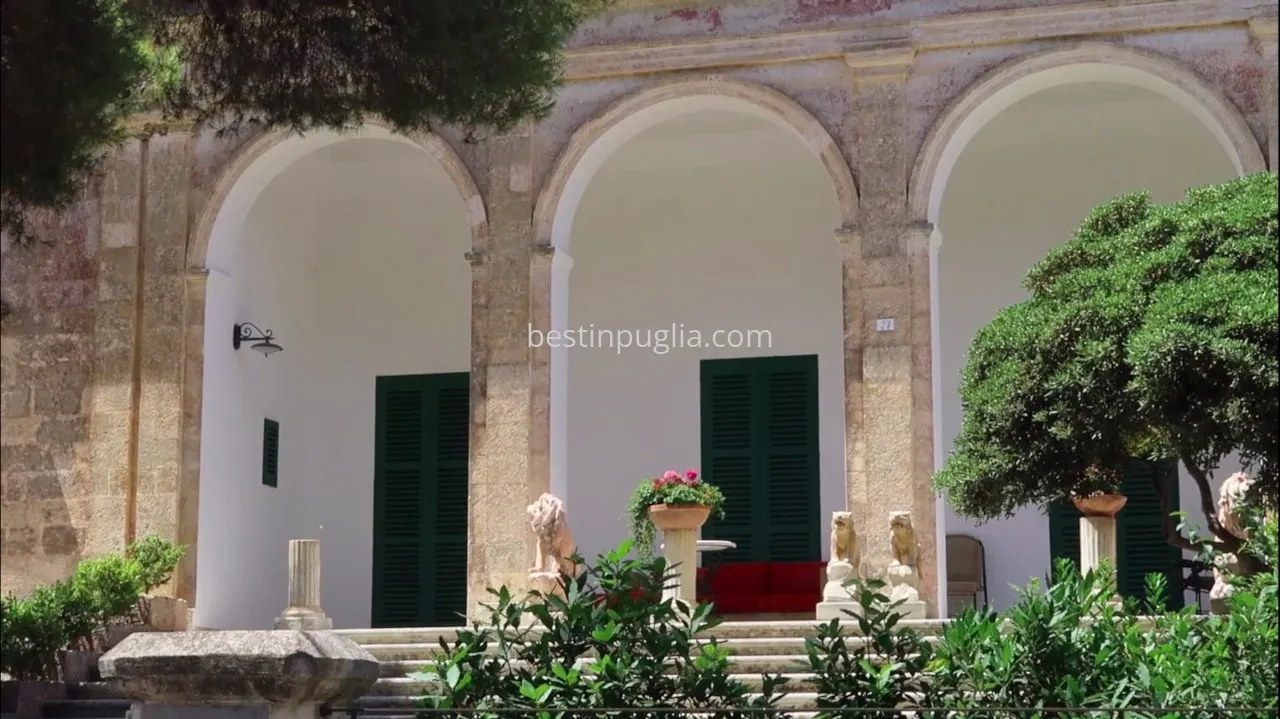
There are several solutions for staying in Leuca during the holidays.
The types of accommodation preferred by tourists during their holidays in Santa Maria di Leuca are:
- Holiday houses
- Hotels
- B&B or Guest house
- Campsites
- 19th century villas
- Farmhouses and Resorts
Holiday houses in Santa Maria di Leuca
The most popular solution for a stay in Leuca is that of short-term leases, or the possibility of renting houses directly from private individuals.
This option is very advantageous in terms of price-quality ratio. By choosing an accommodation in the city center, you can easily walk to the seafront and sandy coves, as well as the beaches and bathing establishments adjacent to the sea.
The houses located in the upper part of Leuca offer a breathtaking panoramic view, but require travel by scooter or car.
Prices vary depending on the type of accommodation and the time of year. However, renting a house directly from the owner, without intermediation costs, allows you to find convenient offers even during the high season.
Hotels
If you are looking for more comfortable and professional accommodation, the hotels in Santa Maria di Leuca are certainly a valid option to consider.
In fact, here you will find various structures that have made the history of hospitality in Leuca, characterized by great professionalism, a strategic position and excellent hospitality.
B&B or Guest house
If you are looking for a welcoming and family-run accommodation, the Bed and Breakfasts and guest houses are certainly the ideal solution for your stay in Leuca.
In recent years, in fact, the offer of this type of structure in Capo di Leuca has grown in proportion to the quality of the services offered, guaranteeing an authentic and comfortable stay experience.
Campsites
If you are a lover of nature and outdoor life, the campsites in Santa Maria di Leuca are the ideal choice for you.
These structures have been managed for several decades and have always represented the reference point of tourism in the Salento plein air.
Furthermore, if you are environmentally conscious, camping allows you to enjoy the surrounding nature while respecting sustainability.
19th century villas
If you want a luxury stay in Santa Maria di Leuca, the nineteenth-century villas are the ideal choice for you.
These private summer residences, often frequented by national and international celebrities, offer an exclusive and refined experience.
You will enjoy the charm of a bygone era with all modern comforts, surrounded by the beautiful landscape of Capo di Leuca.
Farmhouses and Resorts
If you are looking for a luxury holiday in Santa Maria di Leuca, you cannot miss the opportunity to stay in one of the ancient farmhouses restructured into exclusive international-level resorts.
Here you can enjoy a complete wellness experience, with spas and wellness centers at your disposal. This solution is particularly appreciated by customers attentive to detail, who are looking for maximum comfort and relaxation during their stay.
Where is Santa Maria di Leuca located?
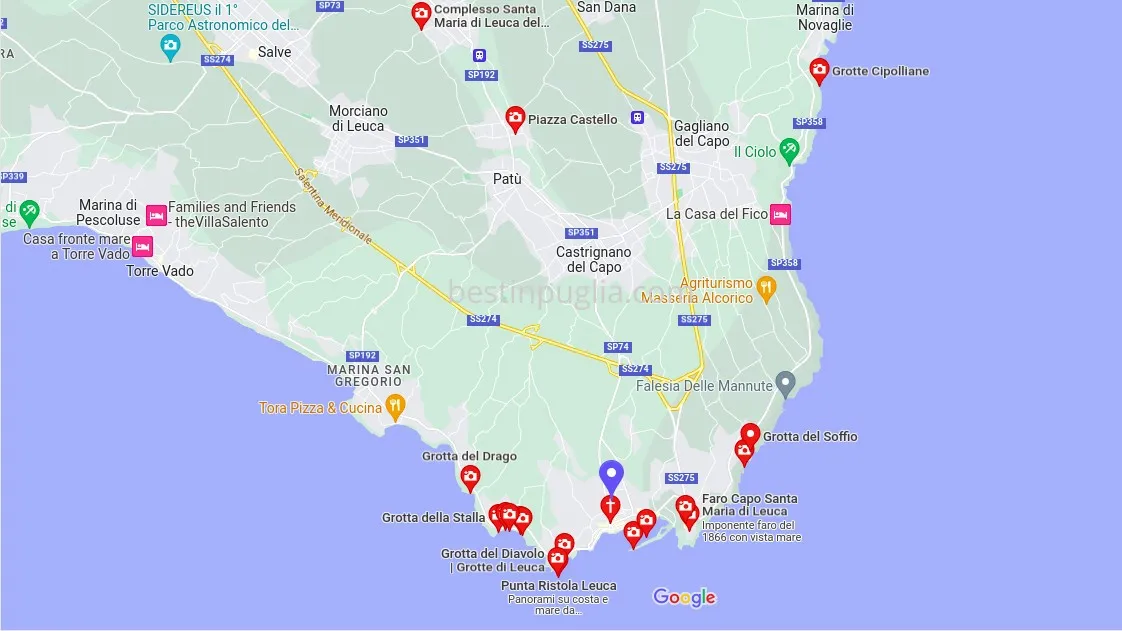
Santa Maria di Leuca is located in the municipality of Castrignano del Capo, in the province of Lecce, and is the southernmost point of Puglia.
Capo di Leuca is the promontory at the extreme tip of Puglia on which the Basilica and the Leuca lighthouse are located, right on the dividing point between the Adriatic and Ionian seas.
The area above the promontory is now identified with Santa Maria di Leuca, while the area under the promontory is recognized with Marina di Leuca, between Punta Meliso to the east and Punta Ristola to the west, i.e. the southernmost part of Salento.
How to get to Santa Maria di Leuca?
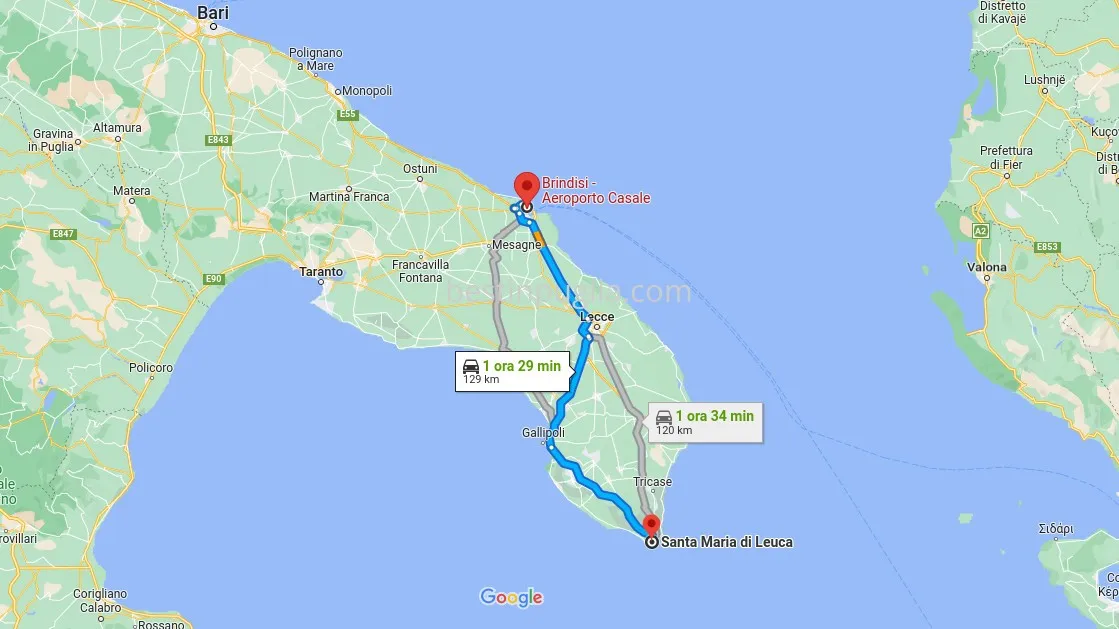
To plan your holiday in Leuca it is essential to have the necessary information to better plan your trip.
Among the ways to get to Santa Maria di Leuca you can choose:
- Train
- Airplane
- Sea
- Car
Train to get to Santa Maria di Leuca
One of the options to get to Santa Maria di Leuca is to use the train of the Ferrovie del Sud Est. The journey will take you to the station of Gagliano del Capo, located just 8 km from Leuca. From here you can take a bus or a taxi to reach your final destination.
Using the train can be a convenient and comfortable choice to reach Santa Maria di Leuca, especially if you are traveling from other regions of Italy. Furthermore, you will be able to enjoy the Salento landscape during the journey, admiring the beauty of the coast and rural landscapes.
It is important to remember to plan your journey in advance, checking train timetables and booking tickets carefully. In this way, you can get to Santa Maria di Leuca easily and without stress, ready to start your adventure in Salento.
Plane to get to Santa Maria di Leuca
To reach Santa Maria di Leuca by plane then Brindisi airport is the best solution.
Brindisi-Salento airport, located about 120 km from Santa Maria di Leuca, is well connected to various destinations in Italy and abroad, representing a convenient solution for those arriving by plane.
Once landed, it is possible to reach Santa Maria di Leuca by car, train or shuttle service.
Boats to get to Santa Maria di Leuca
Leuca can also be reached by sea, landing at the port of Santa Maria di Leuca.
The port is located right in the city center and represents an excellent solution for those arriving by sea. The port is equipped to accommodate boats of different sizes, making it possible for both large yachts and smaller boats to dock.
Once docked at the port, you can enjoy the beauties of the city and the many tourist attractions it offers. In particular, you can visit the lighthouse of Santa Maria di Leuca, one of the symbols of the city, which offers a breathtaking panoramic view of the crystal clear waters of Salento.
It is important to check the information regarding the port of Santa Maria di Leuca in advance, making sure you have all the necessary authorizations for the landing and information on the mooring fee.
Getting to Santa Maria di Leuca by car
There are different options and combinations available to reach Leuca by car, depending on your needs.
The simplest and most direct solution is to take the state road 274, which crosses Salento from north to south and leads directly to Santa Maria di Leuca. This road is well signposted and will allow you to enjoy a beautiful landscape, along the crystal clear sea of Salento.
Rent with driver
If, on the other hand, you prefer to avoid driving and enjoy the journey in total relaxation, you can rent a car at the rental agencies in Leuca, with which it is also possible to arrange the transfer with a driver.
Airport shuttles
In any case, there are also shuttle connections to and from Lecce airport or station, which could be an interesting option if you don't have your own car.
Bus
During the summer months, the SALENTOINBUS service is also active, with various routes that you can consult by contacting the telephone numbers of the information offices in the area. In any case, we advise you to always inform yourself in advance about the transport available, taking into account your needs and the period in which you intend to travel.
